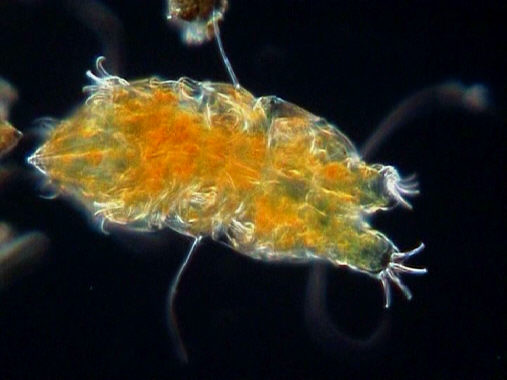raakt straks Het grote welke telescoop moet ik kopen-topic zo vol.
Het gaat hier dus om sterren- planeten- kometen- asteroiden- en deepsky-kijken.
De hemel deze maand
11 december 2005
De maan en de heldere planeet Mars staan rond 21.30 uur dicht bij elkaar aan de hemel, hoog boven de zuidelijke horizon.
Op 12 december wordt Mars door de maan bedekt voor waarnemers in het noordoosten van SiberiŰ.
12 december 2005
Mercurius bereikt vandaag rond 14.00 uur zijn grootste schijnbare afstand ten westen van de zon (ca. 21 graden; zie Handboek sterrenkunde, pag. 138).
De kleine planeet kan kort voor zonsopkomst, vanaf 07.00 uur, gevonden worden laag boven de zuidoostelijke horizon.
Verwar Mercurius niet met Jupiter, die veel helderder is en hoger aan de hemel staat.
13 december 2005
De bijna-Volle Maan beweegt vanavond tussen 20.00 en 21.00 uur vlak onder het Zevengesternte in het sterrenbeeld Stier, hoog aan de zuidoostelijke hemel. Om de sterren van de sterrenhoop te zien, heb je wel een verrekijker nodig.
13 december 2005
Vannacht is het maximum van de Geminiden, een meteorenzwerm met het vluchtpunt in het sterrenbeeld Tweelingen (zie Handboek sterrenkunde, pag. 162).
De stofdeeltjes van de Geminiden zijn afkomstig van de planeto´de Phaethon. Helaas is er vrijwel de gehele nacht veel storend maanlicht.
14 december 2005
Vanavond is er een zeer wijde samenstand van de vrijwel volverlichte maan en de ster Aldebaran in het sterrenbeeld Stier. Kijk vanaf 19.00 uur in het oosten.
15 december 2005
Volle Maan (17.15 uur).
18 december 2005
's Morgens tussen 06.00 en 07.00 uur staat de maan op ÚÚn lijn met de sterren Castor en Pollux in de Tweelingen.
Linksboven de maan is de heldere planeet Saturnus te zien.
18 december 2005
's Avonds is een wijde samenstand te zien van de maan en de planeet Saturnus.
Rond 23.00 uur staat de planeet pal onder de maan, in het oosten.
21 december 2005
De kortste dag van het jaar. Om 19.35 uur bereikt de zon de meest zuidelijke stand aan de hemel en begint officieel de winter (zie Handboek sterrenkunde, pag. 130).
De zon staat nu boven de Steenbokskeerkring.
21 december 2005
's Morgens is een mooie samenstand zichtbaar van de maan en de ster Regulus in de Leeuw.
De kleinste afstand wordt rond 03.00 uur bereikt. Om 05.00 uur staan de twee hemellichamen hoog in het zuiden.
23 december 2005
Laatste Kwartier (20.36 uur).
25 december 2005
De ster Spica in het sterrenbeeld Maagd staat vanmorgen linksonder de maan.
Kijk tussen 06.00 en 07.00 uur in het zuidzuidoosten.
27 december 2005
De maansikkel staat vanmorgen pal onder de heldere planeet Jupiter.
Kijk tussen 06.30 en 07.00 uur in het zuidoosten.
31 december 2005
Nieuwe Maan (04.12 uur).
Interessante objecten:

M104 was het eerste object dat later aan de Messier catalogus werd toegevoegd.
Charles Messier beschreef het object op 11 mei 1781 als een "zeer vage nevel."
Tegenwoordig ook wel bekend als de Sombrero nevel.

De Cassini ruimtesonde draait sinds 2004 in een baan om de planeet Saturnus.
Dagelijks maakt de sonde mooie foto's zoals de foto links.
Daarop zie je de maan Dione en op de achtergrond zie je de atmosfeer van Saturnus en haar ringen.

De Boomerang nevel bevindt zich op een afstand van 5000 lichtjaren bij ons vandaan in het sterrenbeeld Centaurus.
Dagelijks stoot de ster gas en stofdeeltjes uit met een snelheid van bijna 600.000 kilometer per uur.

Op een afstand van 7000 lichtjaren bevindt zich de Arendnevel.
Het hoogtepunt aan Messier Object 16 zijn nog wel de drie gaszuilen in het midden.
Deze hebben een lengte van ongeveer een lichtjaar en verbergen jonge sterren.

Op 4 juli 1054 zagen Chinese astronomen een heldere ster die overdag zichtbaar was.
Een ster explodeerde toen in het sterrenstelsel Stier en dit heeft geresulteerd in de Krabnevel.
Met een redelijke telescoop is deze in de winter zichtbaar.

De Kattenoognevel, ook wel NGC 6543 genoemd, werd in 1786 ontdekt door de astronoom William Herschel.
NGC 6543 is een bijna symmetrische planetaire nevel.
Deze foto is gemaakt met de Hubble Space Telescope van NASA.

Op een afstand van 70 miljoen lichtjaren ligt bevindt zich het sterrenstelsel NGC 1300.
Het is een balkspiraalstelsel en heeft een lengte van 100.000 lichtjaar.
Kijk eens goed in het centrum, want daar zie je ook een spiraalstructuur.
Colliding Galaxies


Gravity3D 1.5 (441 KB)
Celestia Home Page
Wil je zelf in een ruimteschip rondvliegen en de planeten bezoeken? Of wil je liever een kijkje nemen bij andere sterren, zelfs bij exoplaneten? Het is allemaal mogelijk met Celestia. Een prachtig programma met een realistische weergave van objecten.
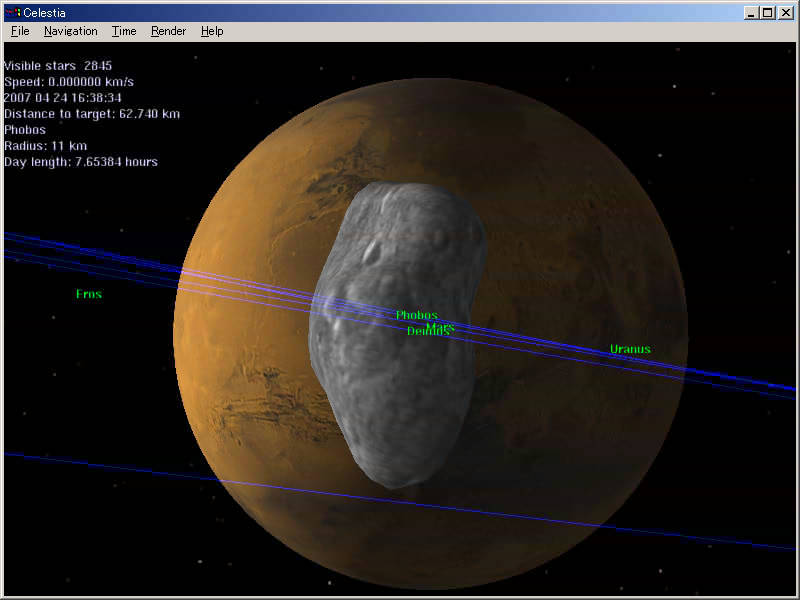
Starcalc Home Page
Ga je vanavond zelf in je eigen tuin waarnemen? Print dan een mooie sterrenkaart waarop alle sterren staan die er die avond te zien zullen zijn. De sterrenkaart bevat alle 110 messier objecten en vele sterren (ook degene die niet met het oog zichtbaar zijn).
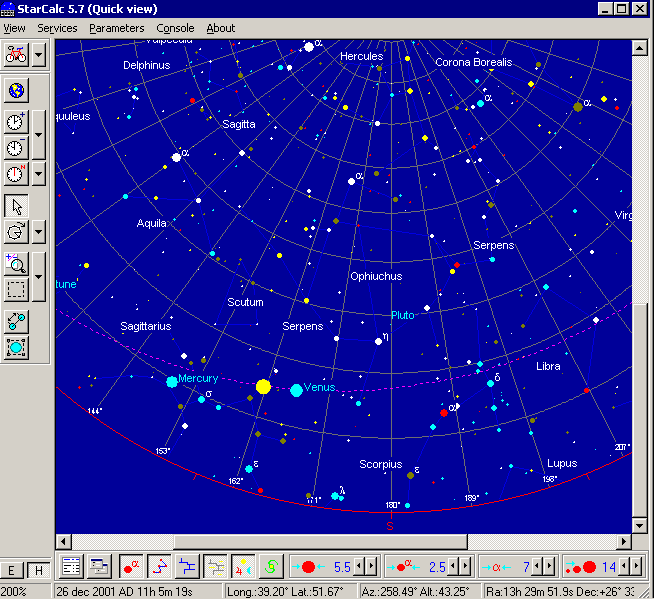
Winorbit Home Page
Wanneer komt een bepaalde satelliet over de aarde? Dat kun je voorspellen met dit mooie programma. Je kunt zelfs je eigen woonplaats opgeven en dan voorspelt het programma wanneer er een heldere satelliet zal opflitsen. Handig en snel.

Wat links:
Astronomie algemeen:
Alles over Sterrenkunde
De Koepel
Astrostart
Astronomie
Astronieuws
Astronomie nieuws
Vereniging voor Sterrenkunde Midden-Limburg
Sterrenweb
Space.com
Astronomynow
Spacedaily
Nightsky
Astronomie:
Zonnestelsels op schaal (tip!)
De negen planeten
Astroiden
Meteoren
Cometen
Het Heelal
Exoplaneten
Zwarte gaten
Urania
Sterrenwachten:
Urania
Mercurius
Astrofotografie:
Astronomy picture of the day
Astro-fotografie
Astrofotografie
Webcam Astrofotografie
Winkels:
Aquariusoptics
Ganymedes
Focal Point
Optical-systems
Astroproducts
Urania Shop
Astronomie software:
Starrynight
Maris
Deepsky
Skymap
freeware & shareware
Hemelkaarten:
Hemelkaarten
Your Sky
Sky survey
Sky view
Virtual Observatory
Gigantische lijst links
[ Bericht 5% gewijzigd door Quarks op 12-12-2005 21:51:20 ]
te volgen topic?
en dus ook een tvp
quote:Terugvindpost, alhoewel jouw variant wel inventief isOp maandag 12 december 2005 19:52 schreef Boswachtertje het volgende:
weet niet wat het nou precies betekent maar: tvp
te volgen topic?
quote:Ghehe komt min of meer op hetzelfde neer!Op maandag 12 december 2005 19:55 schreef Reya het volgende:
Terugvindpost, alhoewel jouw variant wel inventief is
Quarks, heeft je zeker wel wat tijd gekost, dit zo bij elkaar te zoeken!
Thanks daarvoor, ga morgen eens rustig alle info doorlezen, wilde altijd al meer weten van astronomie en zie hier dit pre-christmas-geschenk waar ik je dankbaar voor ben
Ons zonnestelsel op schaal.
Ik wou hier een wat algemener topic van maken.
quote:BronMoon to Hide Beautiful Star Cluster
During the next several years, skywatchers around the globe will periodically get a chance to watch the Moon pass in front of the most beautiful of all star clusters, the Pleiades. It will happen thirteen times in 2006 alone, beginning in January.
The easy-to-view events provide an excellent excuse to pull an old telescope out of the closet or buy a new one.
Astronomers refer to this phenomenon as an “occultation,” taken from the Latin word occult?re, which means, “to conceal.” In most cases, the Moon will hide a bright star or planet, but by passing in front of a cluster of stars like the Pleiades, many stars will be occulted within a span of a few hours.
Few star figures are as familiar as the Pleiades, known also as the Seven Sisters. Anyone having difficulty in recognizing various stars and constellations should start with this star pattern. This group looks at first glance to the naked eye like a shimmering little cloud of light.
But further examination will reveal a tight knot of 6 or 7 stars, though 11 or more have been recorded under excellent conditions. In long-exposure photographs, several stars in the cluster seem to be enveloped in clouds of dust, perhaps left over from the stuff of which they were formed. About 410 light-years away and some 20 light years across, the group may be no older than 20 million years. About 250 stars have been identified as members of this cluster.
The brightest stars glitter like an array of icy blue diamonds on black velvet. Or, as Tennyson wrote, they “glitter like a swarm of fireflies tangled in a silver braid.”
The last occultations of the Pleiades took place between 1986 and 1992. Since this cluster lies 4║ north of the ecliptic, it can be occulted only when the ascending node of the Moon’s orbit is in the Pisces-to-Sagittarius part of the ecliptic. This situation repeats every 18.6 years, the time required for the ascending node to complete one circuit of the ecliptic. Hence, a new “season” of Pleiades occultations has begun that will continue until the year 2010.
Since the Pleiades are roughly twice as large as the Moon in apparent angular diameter only a part of the cluster can be hidden at any given moment; the Moon can never hide the entire cluster. The seven brightest Pleiads are (on average) around fourth magnitude. They are, in order of brightness: 1) Alcyone, magnitude +2.9; 2) Atlas, +3.6; 3) Electra, +3.6; 4) Maia, +3.8; 5) Merope, +4.2; 6) Taygeta, +4.3; 7) Pleione, +5.1.
It should also be noted, that in most cases, using binoculars or a telescope you’ll likely be able to watch perhaps up to several dozen occultations of the fainter stars in this cluster within a few hours.
In the table, below, is the complete list of Pleiades occultations through 2006, which will chiefly favor locations over the Northern Hemisphere. Note that each occultation will be visible only for a specific region of the Earth. In other areas, either the Moon will appear to miss the cluster or the event occurs during the daytime or when the Moon and Pleiades are below your local horizon. Even if your area is not in a favored position to see an occultation, you’ll still see the Moon and the Pleiades rather close to each other on the date in question. The date and universal time (U.T.) are given for the midpoint of each event. To convert to your time zone, keep in mind that U.T. that you will need to subtract five hours for Eastern Time, six hours for Central Time, seven hours for Mountain Time and eight hours for Pacific Time. When daylight saving time is in effect, subtract four hours for Eastern Time, five hours for Central Time, etc.
Also important: In some cases, after converting to your time zone, make sure you check to see if the occultation occurs on the previous calendar day. For example: 2006 April 2 at 01h U.T. converts to 2006 April 1 at 20h (9:00 p.m.) Eastern daylight time!
The percentage of the Moon’s disk that is illuminated is also provided. Remember that in the case of a waxing Moon, stars will disappear along the Moon’s dark limb and reappear along the Moon’s bright limb; with a waning Moon the stars will vanish first along the bright limb and pop back into view along the dark limb.
The very best Pleiades occultations will be those involving a crescent Moon, where the Moon’s light is not overly bright. In addition, Earthshine may also be evident as a faint grayish-blue illumination of the dark part of the Moon’s disk. This dim light is produced by sunlight striking the “dark” side of the Moon after first being reflected from the Earth’s surface, clouds and atmosphere. This effect will give the Moon an almost 3-D quality and will only serve to enhance the overall view. The April and July occultations which favor eastern North America, should be especially striking and Night Sky will provide detailed outlooks as we draw nearer to both of these events.
quote:De Smart-1 The Moon Pictures is al maanden bezig met de opnamesOp maandag 12 december 2005 22:10 schreef Kered het volgende:
Is de SMART-1 al aangekomen? Te weinig water op de maan voor plan Bush
[ Bericht 11% gewijzigd door -CRASH- op 12-12-2005 23:06:25 ]
quote:Het was dus december 2004 in plaats van 2005Op maandag 12 december 2005 22:34 schreef -CRASH- het volgende:
[..]
De Smart-1 The Moon Pictures is al maanden bezig met de opnames
Ook eindelijk een topic waar ik eens kan vertellen over het volgende:
IAYC - International Astronomical Youth Camp
Zomerkamp, ieder jaar ergens anders in Europa. Ongeveer 70 man van over heel de wereld (voornamelijk Europa) leven 3 weken bij elkaar om sterrenkunde te beoefenen.
Misschien leuk voor een aantal mensen hier die van de zomer nog niks te doen hebben. Dit jaar in TsjechiŰ. www.iayc.org (Spam voor een non-profit organisatie is toch geen spam?)
Vragen: kunnen aan mij.
Goeie OP
quote:Hubble Sheds Light on Dark Matter
Astronomers don’t know what it is, but every now and then they find more evidence of dark matter and pin down where the mysterious stuff resides.
A new project that recycled Hubble Space Telescope images has mapped the invisible dark matter with unprecedented detail. Researchers focused on two galaxy clusters that are so far away, and their light has taken so long to get here, that they are seen as they existed when the universe was about half its present age.
The observations provide additional evidence supporting a leading theory that galaxies form in cosmic webs, with regular material and dark matter condensing into nodes something like water drops gather at intersections of spider silk.
You can also think of it as froth gathering on the tops of ocean waves, said study team member Myungkook James Jee at Johns Hopkins University.
Strange stuff
Dark matter is thought to exist because without it, galaxies would fly apart for lack of gravitational glue. However mapping something that can’t be seen is problematic.
"It is very challenging to verify the simulation results observationally, because dark matter does not emit light," Jee said.
The trick is to look for subtle distortions in the images caused by gravitational lensing, in which the shapes of very distant galaxies are warped by dense concentrations of matter between us and the galaxies. The matter, which is not visible, bends the light with its gravity, and that reveals its presence.
"The images we took show clearly that the cluster galaxies are located at the densest regions of the dark matter haloes, which are rendered in purple in our images," Jee said.
The results are detailed in the December issue of Astrophysical Journal.
Dark matter makes up about 90 percent of the universe’s total. Theory holds that it should gather with regular matter, because of their mutual effects of gravity. The new observations support that idea, Jee said.
The work also supports the notion that dark matter is not made of particles that can collide. It’s not known if dark matter involves particles at all, but if so, they must be collisionless.
"Collisionless particles do not bombard one another, the way two hydrogen atoms do," Jee said. "If dark matter particles were collisional, we would observe a much smoother distribution of dark matter, without any small-scale clumpy structures."
The two clusters each contain more than 400 galaxies.
"These images were actually intended mainly to study the galaxies in the clusters, and not the lensing of the background galaxies," said co-researcher Richard White of the Space Telescope Science Institute, which operates Hubble for NASA. "But the sharpness and sensitivity of the images made them ideal for this project. That's the real beauty of Hubble images: They will be used for years for new scientific investigations."

Kannibalistisch zwart gat zorgt voor gammaflits
Een internationaal team van astronomen heeft een derde korte gammastraling uitbarsting gevonden, geassocieerd met een nabij elliptisch sterrenstelsel. Aangezien er niet veel sterformatie plaatsvindt in zulke sterrenstelsels, denken astronomen dat de uitbarsting is ontstaan toen een neutronenster werd 'opgegeten' door een zwart gat.
Gammastraling uitbarstingen zijn krachtige explosies in het heelal die voor het eerst werden ontdekt aan het eind van de jaren '60. Ze komen willekeurig voor en gebeuren overal waar je maar kijkt. Probeer maar eens de locatie van een flits van een camera te vinden in een vol stadion, dan voel je je als een wetenschapper die gammastraling uitbarstingen aan het zoeken is.
Twee jaar geleden kwamen wetenschappers erachter dat lange uitbarstingen ontstaan wanneer zeer massieve sterren exploderen. Ongeveer 30 procent van de uitbarstingen zijn echter korte uitbarstingen onder de twee seconden.
Uit recente observaties naar aanleiding van twee eerdere korte gammastraling uitbarstingen kwam naar voren dat zulke gammaflitsen ontstaan door het samenvoegen van zeer compacte objecten, zoals neutronensterren en zwarte gaten. Korte gammaflitsen ontstaan als een zwart gat botst met een neutronenster of als er een botsing plaatsvindt tussen twee neutronensterren. In het eerste scenario eet een zwart gat een neutronenster op en wordt zo zwaarder. In het tweede scenario vormen de twee neutronensterren een zwart gat.
De derde gammaflits werd op 24 juli 2005 gevonden met de Swift satelliet en kreeg de benaming GRB 050724. Het sterrenstelsel - waar de gammastraling uitbarsting werd gevonden - bevindt zich op een afstand van 3 miljoen lichtjaren bij ons vandaan. De uitbarsting vond 13.000 lichtjaren van het centrum plaats en had een roodverschuiving van 0.258.

Bron
http://www.nu.nl/news/642(...)jk_naar_de_maan.html
http://www.refdag.nl/artikel/1241747/
quote:Ik ga gewoon even ordinair linken naar ÚÚn van mijn topics over de kosmologische constante. Als we het dan toch over donkere materie hebben
quote:Ga je gangOp maandag 19 december 2005 10:58 schreef Haushofer het volgende:
[..]
Ik ga gewoon even ordinair linken naar ÚÚn van mijn topics over de kosmologische constante. Als we het dan toch over donkere materie hebben
quote:Was de link vergeten er neer te zetten
klik
De kosmologische constante is in dit opzicht heel interessant, omdat het gezien kan worden als een nulpuntsenergie.
Zoiets wil ik wel in mijn hoofd hebben zweven
Oh Oh Oh wat een mooie kleuren.....
Meteen maar richting bookmarks deze topic
quote:Stem ook op de "Best space images of 2005"The Big Bangs for Astronomers in 2005
PHOENIX, Ariz. -- The past year in space science and astronomy was dominated by debate and some tantalizing near-findings.
A hangover of heady Mars discoveries festered while astronomers on the ground obtained evermore intimate glimpses of the outer solar system and the solar neighborhood but stopped short of declaring agreement on what they’d found. To punctuate that ambiguity with some stark clarity elsewhere, NASA smacked a comet and found it to be all fluff.
Among the highlights:
The 10th Planet?
You might think the discovery of an object larger than Pluto orbiting the Sun would automatically be hailed as the long-sought 10th planet. Caltech’s Mike Brown and his colleagues figured as much. Not so fast, many astronomers said. This new world is one of perhaps thousands out there that await discovery. Will we call them all planets? Should Pluto even be considered a planet? In a weird twist to the debate, Brown suggests we all ignore the scientific debate and let culture decide. One has to wonder if that’s the sort of ambiguity science ought to promote.
Signs of Life on Mars?
This story extends back to last year and looks like the sort of mystery that’ll keep scientists scratching their heads for years to come. The air of Mars seems to contain pockets of methane in doses that should not exist. Perhaps it’s the belchings of subsurface microbes, European astronomers said early this year. They support that view with new evidence for blocks of underground ice in the same region as the methane, based on observations by ESA’s Mars Express. The ice could be supplying the precious liquid water needed to support the biology, they figure. Other astronomers think the reasoning is very speculative, however.
Super-Earth Discovered
Astronomers expect to eventually find many Earth-sized planets around other stars. But technology can’t spot such small objects yet. Pushing the limits of existing methods, Paul Butler of the Carnegie Institution of Washington and colleagues detected a world just 7.5 times the mass of Earth orbiting another star and said it must be rocky. This year marked the 10th anniversary of the discovery of the first extrasolar planet around a normal star, and astronomers have gathered enough data on about 150 planets since then to say, in the words of planet-hunting guru Geoff Marcy of the University of California, Berkeley, "I imagine most stars have terrestrial planets. It seems hard not to form them."
Birth of a Black Hole
An explosion 2.2 billion years ago, whose light just arrived at Earth this year, was detected and then monitored by an unprecedented array of telescopes on the ground and in space. The event prompted a furious exchange of e-mails. Within moments, the scientists, led by Neil Gehrels of NASA’s Goddard Space Flight Center, suspected they had seen the birth of a black hole as it happened (well, except for that previously mentioned time lag of 2.2 billion years). The event was triggered by the merger of two neutron stars, the thinking goes.
First Photo of an Extrasolar Planet?
A series of announcements about the possible first picture of a planet around another star ended up in a debate that has yet to be resolved. In 2004 a team based at the European Southern Observatory (ESO) said they had made what they said was likely the first picture of an extrasolar planet. The object, 2M1207b, appeared bound to a young but failed star known as a brown dwarf sitting about 200 light-years from Earth.But it was also possible that 2M1207b was instead a distant background object.
This past April, Ralph Neuhaeuser of the Astrophysical Institute & University Observatory said his team had made the first confirmed picture of a planet around another star called GQ Lupi, some 400 light-years away. Both pictures are real, but astronomers can’t agree on the masses of the objects in the images or, for that matter, how to state the difference between large planets and small stars. We’ll have to wait for history to tell us if this was a big story or not.
Protecting Ourselves
Some day, scientists have been telling us for some years now, we’ll have to deal with an incoming asteroid or comet that would destroy civilization at worst or wipe out a city at least. Big impacts have occurred before, and there will be more. But we don’t know enough about space rocks and their composition to plan properly for deflecting or destroying such a menace. Turnabout proved to be fair play when NASA’s Deep Impact mission slammed a probe into Comet Tempel 1 on the 4th of July.
The upshot? This comet was fluffy, unlike others that have been studied up close. Meanwhile, a group of scientists and astronauts, led by Russell Schweickart, a former Apollo astronaut, prodded NASA to visit asteroid Apophis, which has a slight chance of hitting us a few decades hence. NASA’s response: A purely scientific mission might be considered, but we have plenty of time to mount a diversion if further observations show this thing would really hit.
Een paar genomineerden:



Kost wel een paar centjes..... $ 299.00
quote:MaxDSLR Astrophotography Software for Digital SLR camera users!
MaxDSLR makes it easy to focus, guide, capture RAW frames, and stack multiple exposures.
Image Processing
Use MaxDSLR to turn your raw frames into a gorgeous celestial vista.
MaxDSLR
Astrophotography Software for Digital SLR camera users!
With the new breed of Digital SLR cameras, astrophotography is now within reach of many amateur astronomers. As DSLRs are not able to take single long exposures, software like MaxDSLR can be used to extend the exposure time and to stack multiple images to create great astrophotos.
High quality imaging with DSLRs requires proper focus, good guiding, capturing RAW frames, and stacking multiple long exposures. MaxDSLR makes this easy. MaxDSLR provides a complete set of focus tools, including a rapid image download mode, 3-D focus graph, and measurement of peak, FWHM, and Half Flux Diameter. In addition, with suitable digitally-controlled focuser, MaxDSLR can provide full autofocus.
Connect a webcam, DSI, LPI, or Lumenera camera for use as an autoguider – or use it as the main camera for deep sky or planetary imaging. For optimum RAW frame capture, MaxDSLR will directly download raw images from the camera, and save them in FITS format. Raw frames are best because they have higher bit depth, have not been compressed, and have not been debayered (converted to color). This is the optimum format for dark frame and flat field correction, and provides the highest dynamic range.
Sequencing allows you to take multiple frames at different exposures times and different ISO settings. This can be used to optimize detection of both bright and faint objects in the field. MaxDSLR supports popular shutter control cables, to allow for longer single exposures. Stacking longer individual frames results in lower overall read noise, producing deeper images faster.
What about RAW frames saved on the camera's flash card? No problem! MaxDSLR reads RAW frames from popular DSLR cameras. Once the images have been acquired, MaxDSLR provides a complete suite of processing tools. Batch process all your exposures for dark and flat calibration, conversion to color (Debayer), etc. Then stack the images with optional auto-alignment to produce the highest quality image.
MaxDSLR is designed for digital camera users who want to take high quality images of celestial objects. MaxDSLR provides a number of important benefits to DSLR users:
Support for Canon, Nikon, Olympus, webcams, DSI, LPI, and Lumenera cameras
Reads DSLR RAW formats
Built-in focus tools
Built-in autoguiding
Longer individual exposures via add-on shutter control cable
Automatic exposure sequences
Raw frame processing for optimum dark subtraction and high bit depth
Automatic stacking with auto-alignment
Advanced processing feature such as Range Restricted FiltersTM, color balance and saturation adjustment
MaxDSLR features include:
Reads popular DSLR RAW formats
Kernel Filters
Unsharp Mask
Digital Development Processing (DDP)
Adjust color balance and saturation
Export to FITS, TIFF, JPEG, PNG, or BMP format
New buffering technology handles high bit depth, multi-megapixel images
System Requirements
Windows« 98, 98SE, NT 4,0, 2000 or XP, 512 MB RAM, 20 MB disk space, 1024x768 minimum video recommended (800x600 minimum), 16- bit color (8-bit minimum), Internet Explorer 4 or higher
quote:MooiOp woensdag 21 december 2005 22:53 schreef -CRASH- het volgende:
interessante software voor de amatuer astro-fotografen onder ons....
Kost wel een paar centjes..... $ 299.00
[..]
$299 is geen geld voor een fatsoenlijk software pakket hoor.
quote:koers ligt ongeveer gelijk, zie ik.Op woensdag 21 december 2005 23:03 schreef Quarks het volgende:
Mooi
$299 is geen geld voor een fatsoenlijk software pakket hoor.
$ 1.1977 ..... EU 1.1872
quote:Gedetailleerd beeld van centrum melkwegstelsel
Astronomen van de universiteit van Californie in Los Angeles en hun collega's hebben de eerste gedetailleerde foto van het centrum van ons melkwegstelsel gemaakt, inclusief het gebied rondom het supermassieve zwarte gat. Hiervoor werd een nieuwe laser gebruikt bij het W. M. Keck observatorium in Hawaii.
"Alles is veel duidelijker nu," aldus Andrea Ghez, professor in fysica en astronomie aan de universiteit en leider van het onderzoeksteam. "We hebben een laser gebruikt om het beeld van de telescoop te verbeteren. Dit is een spectaculaire doorbraak, want nu kunnen we zwarte gaten nog beter begrijpen."
Astronomen zijn gewend aan het werken met wazige foto's, wat komt door de atmosfeer van de aarde. Een laser kan echter deze atmosferische verstoringen corrigeren en hierdoor ontstaan heldere foto's. Deze nieuwe technologie, wat Laser Guide Star adaptieve optiek wordt genoemd, zal leiden tot nieuwe ontdekkingen in de kosmos.
"We zijn al jaren op zoek naar technieken om de verstoringen in de atmosfeer te 'verslaan' en om hoge resolutie foto's te produceren," zei ze. "We zijn blij dat de eerste observaties met de laser succesvol zijn verlopen."
Hieronder de foto's van de kern van ons melkwegstelsel. Links de nieuwe foto en rechts de foto zonder gebruik te maken van de laser. Zie jij het verschil?

quote:Kunnen ze niet gewoon hubble gebruiken?
quote:Hubble is niet van hun.Op donderdag 22 december 2005 18:17 schreef Kered het volgende:
[..]
Kunnen ze niet gewoon hubble gebruiken?
Weet je wel hoeveel het kost om hubble te gebruiken.
quote:New Moons and Rings Found at Uranus
Astronomers have discovered new rings and small moons around Uranus and found surprising changes in satellite orbits around the giant planet.
NASA's Hubble Space Telescope photographed a pair of previously unknown rings. The largest is twice the diameter of the planet's previously known rings. The new rings are so far from the planet that they are being called Uranus's "second ring system."
Hubble also spotted two small satellites. One shares its orbit with one of the newly discovered rings. Most surprisingly, the orbits of Uranus's family of inner moons have changed significantly in the last decade, the new data reveal.
Collectively, the discoveries mean Uranus has a densely packed, rapidly changing, and possibly unstable dynamical system of orbiting bodies.
"The new discoveries dramatically demonstrate that Uranus has a youthful and dynamic system of rings and moons," says Mark Showalter of the SETI Institute. "Until now nobody had a clue the rings were there, we had no right to expect them."
Since dust in such an orbit is expected to be depleted by spiraling away, the rings must be continually replenished with fresh material. Showalter and collaborator Jack Lissauer of the NASA Ames Research Center propose that the outermost ring is replenished by a 12-mile-wide companion satellite, named Mab, which they first saw in 2003 using Hubble. Meteoroid impacts continually blast dust off the surface of Mab, and the dust then spreads out into a ring around Uranus.
Other small moons are linked to rings, including Amalthea at Jupiter, Pan at Saturn, and Galatea at Neptune.
Mab's ring receives a fresh infusion of dust from each impact. In this way, nature "balances the books" by keeping the ring supplied with new dust while older dust spirals away or bangs back into the moon, the thinking goes.
Showalter and Lissauer have measured numerous changes to the orbits of Uranus's inner moons since 1994.
“This appears to be a random or chaotic process, where there is a continual exchange of energy and angular momentum between the moons," Lissauer said. "The changes in the last ten years are small, but the thing about chaos is that small changes build up exponentially with time. As a result, this suggests that the entire system is orbitally unstable."
The moons may begin to collide in a few million years, Lissauer figures.
Perhaps the most unstable moon of all is tiny Cupid, whose orbit brings it within 500 miles of the moon Belinda.
Showalter and Lissauer propose that their discovery of a second ring, which orbits closer to the planet than the new outermost ring, provides further evidence for collisional evolution of the system. This ring orbits in the midst of the moons but has no visible body to re-supply it with dust.
"This ring may be the telltale sign of an unseen belt of bodies a few feet to a few miles in size," Showalter said. He proposes that the collisional disruption of a moon in Uranus's past could have produced the debris ring they now observe.

quote:Helaas geen missie naar Uranus...Op vrijdag 23 december 2005 12:40 schreef star_gazer het volgende:
Waarom sturen ze nou geen misssie naar Uranus... We weten nog veels te weinig van die planeet!
En zal ook NIET bezocht worden door de
New Horizon missie
die naar Pluto en de Kuiperbelt gaat
Klik foto om een 31 MB tif formaat te downloaden

quote:New Horizons
The New Horizons Pluto-Kuiper Belt Mission will help us understand worlds at the edge of our solar system, by making the first reconnaissance of Pluto and Charon – a "double planet" system and the last in our solar system to be visited by spacecraft. The mission will then visit one or more Kuiper Belt Objects, in the region beyond Neptune. (Launch: 2006 January)
[ Bericht 1% gewijzigd door -CRASH- op 23-12-2005 13:14:20 ]
quote:Vergeten, dank jeOp vrijdag 23 december 2005 12:34 schreef -CRASH- het volgende:
Moet je ook ff de foto's erbij plaatsen Quarks
[afbeelding]
quote:An Explosion on the Moon
23-12-2005
So you thought nothing ever happens on the moon?
Right: The red dot marks the location of the Nov. 7, 2005, meteoroid impact. Credit: NASA/MSFC/Bill Cooke. Larger Image
December 23, 2005: NASA scientists have observed an explosion on the moon. The blast, equal in energy to about 70 kg of TNT, occurred near the edge of Mare Imbrium (the Sea of Rains) on Nov. 7, 2005, when a 12-centimeter-wide meteoroid slammed into the ground traveling 27 km/s.
"What a surprise," says Marshall Space Flight Center (MSFC) researcher Rob Suggs, who recorded the impact's flash. He and colleague Wes Swift were testing a new telescope and video camera they assembled to monitor the moon for meteor strikes. On their first night out, "we caught one," says Suggs.
The object that hit the moon was "probably a Taurid," says MSFC meteor expert Bill Cooke. In other words, it was part of the same meteor shower that peppered Earth with fireballs in late October and early November 2005.
The moon was peppered, too, but unlike Earth, the moon has no atmosphere to intercept meteoroids and turn them into harmless streaks of light. On the moon, meteoroids hit the ground--and explode.
"The flash we saw," says Suggs, "was about as bright as a 7th magnitude star." That's two and a half times dimmer than the faintest star a person can see with their unaided eye, but it was an easy catch for the group's 10-inch telescope.
Cooke estimates that the impact gouged a crater in the moon's surface "about 3 meters wide and 0.4 meters deep." As moon craters go, that's small. "Even the Hubble Space Telescope couldn't see it," notes Cooke. The moon is 384,400 km away. At that distance, the smallest things Hubble can distinguish are about 60 meters wide.
This isn't the first time meteoroids have been seen hitting the moon. During the Leonid meteor storms of 1999 and 2001, amateur and professional astronomers witnessed at least half-a-dozen flashes ranging in brightness from 7th to 3rd magnitude. Many of the explosions were photographed simultaneously by widely separated observers.
Above: The Nov. 7th lunar Taurid explosion, shown as a sequence of 6 false-color video frames. Credit: Wes Swift/NASA
Since the Leonids of 2001, astronomers have not spent much time hunting for lunar meteors. "It's gone out of fashion," says Suggs. But with NASA planning to return to the moon by 2018, he says, it's time to start watching again.
There are many questions that need answering: "How often do big meteoroids strike the moon? Does this happen only during meteor showers like the Leonids and Taurids? Or can we expect strikes throughout the year from 'sporadic meteors?'" asks Suggs. Explorers on the moon are going to want to know.
"The chance of an astronaut being directly hit by a big meteoroid is miniscule," says Cooke. Although, he allows, the odds are not well known "because we haven't done enough observing to gather the data we need to calculate the odds." Furthermore, while the danger of a direct hit is almost nil for an individual astronaut, it might add up to something appreciable for an entire lunar outpost.
Of greater concern, believes Suggs, is the spray—"the secondary meteoroids produced by the blast." No one knows how far the spray reaches and exactly what form it takes.
Also, ground-shaking impacts could kick up moondust, possibly over a wide area. Moondust is electrostatically charged and notoriously clingy. (See "Mesmerized by Moondust" from Science@NASA.) Even a small amount of moondust can be a great nuisance: it gets into spacesuit joints and seals, clings to faceplates, and even makes the air smell when it is tramped indoors by moonwalkers. Could meteoroid impacts be a source of lunar "dust storms?" Another question for the future....
Suggs and his team plan to make more observations. "We're contemplating a long-term monitoring program active not only during major meteor showers, but also at times in between. We need to develop software to find these flashes automatically," he continues. "Staring at 4 hours of tape to find a split-second flash can get boring; this is a job for a computer."
With improvements, their system might catch lots of lunar meteors. Says Suggs, "I'm ready for more surprises."
quote:As far as they know, Suggs and Swift were the only ones who recorded the impact of Nov. 7th—"probably because we were the only ones looking," says Suggs. So, unlike the lunar Leonids of 1999 and 2001, the lunar Taurid of 2005 was not confirmed by a second or third observer.
Nevertheless, "we are 99% sure it was real," says Suggs.
Other possibilities include
a satellite passing in front of the moon, glinting in sunlight;
a cosmic ray hitting the video camera's CCD chip;
a meteor in Earth's atmosphere, directly between Earth and the Moon.
"We don't believe it was a satellite," says Cooke who, together with aerospace engineer Heather McNamara, searched through NORAD's catalogue of 8363 "trackable objects" in Earth orbit. "There was no unclassified satellite or piece of space debris in the right place at the right time to cause the flash."
It couldn't have been a cosmic ray. "We observed the lunar explosion in five consecutive video frames (total time span: 150 msec). A cosmic ray would have caused a flash in only one frame," explains Suggs.
[ Bericht 2% gewijzigd door -CRASH- op 23-12-2005 20:54:00 ]
Zou wel lullig zijn
quote:Als Global Dimming effect heeft op de zonOp zondag 25 december 2005 03:22 schreef Kered het volgende:
Ik vroeg me zomaar af: heeft global dimming ook invloed op de zichtbaarheid van sterren?
Zou wel lullig zijn
dan heeft het ook zeker effect op het sterrenlicht.
quote:Tel lichtvervuiling er bij op...Op zondag 25 december 2005 15:20 schreef -CRASH- het volgende:
[..]
Als Global Dimming effect heeft op de zon
dan heeft het ook zeker effect op het sterrenlicht.
Plus dat de aerosolen, die de global dimming veroorzaken, de lichtvervuiling waarschijnlijk versterken.
Maar zonder global dimming loopt het global warming weer zwaar uit de klauw, maar met global warming krijgen we weer meer opstijgende warme lucht.
Ja mensen, het zijn slechte tijden voor sterrenkijkers op aarde
quote:Misschien dat Spitzer goedkoper is?Op vrijdag 23 december 2005 10:55 schreef Quarks het volgende:
[..]
Hubble is niet van hun.
Weet je wel hoeveel het kost om hubble te gebruiken.
[..]
http://www.spitzer.caltech.edu/
3 januari 2006
Vandaag bereiken de Bo÷tiden hun maximum. Deze meteorenzwerm heeft zijn vluchtpunt in het sterrenbeeld Bo÷tes. De waarnemingsomstandigheden zijn gunstig: er is weinig storend maanlicht.
4 januari 2006
Rond 16.00 uur bereikt de aarde het punt van zijn elliptische baan waar de afstand tot de zon het kleinst is: 147.103.625 kilometer - ruim anderhalf procent kleiner dan gemiddeld.
6 januari 2006
Eerste Kwartier (19.56 uur).
8 januari 2006
Vanavond vindt een zeer nauwe samenstand plaats van de ruim half verlichte maan en de planeet Mars, vlak onder de maan. Bekijk het tweetal tussen 20.00 en 21.00 uur, hoog boven de zuidelijke horizon.
9 januari 2006
Vannacht beweegt de maan vlak langs het Zevengesternte, de open sterrenhoop in het sterrenbeeld Stier. Gebruik een verrekijker om de sterrenhoop te zien, linksboven de heldere maan. De kleinste afstand wordt bereikt rond 04.00 uur (10 januari).
12 januari 2006
Jupiter staat vannacht dicht bij de ster Zubenelgenubi in het sterrenbeeld Weegschaal. Kijk 's morgens rond 07.00 uur boven de zuidelijke horizon.
14 januari 2006
De planeet Venus staat vandaag rond 01.00 uur in benedenconjunctie met de zon: hij beweegt tussen de aarde en de zon door, en is dus enige tijd niet zichtbaar.
14 januari 2006
Volle Maan (10.48 uur). De maan bevindt zich vannacht halverwege de sterren Castor en Pollux in het sterrenbeeld Tweelingen en de planeet Saturnus in de Kreeft.
15 januari 2006
's Morgens rond 08.00 uur zie je Saturnus links van de ondergaande maan, in het westen. 's Avonds rond 20.00 uur staat hij rechts van de opkomende maan, laag in het oosten.
17 januari 2006
Samenstand van de maan met de ster Regulus in het sterrenbeeld Leeuw. Kijk 's morgens tussen 06.00 en 08.00 uur, vrij laag in het westzuidwesten.
22 januari 2006
Laatste Kwartier (16.14 uur). De maan staat 's morgens rond 07.00 uur links van de ster Spica in het sterrenbeeld Maagd, vrij laag in het zuiden.
23 januari 2006
Links van de afnemende maan is de heldere planeet Jupiter te zien. Kijk 's morgens rond 07.00 uur in het zuiden.
25 januari 2006
In de ochtendschemering is links van de maan de ster Antares in het sterrenbeeld Schorpioen zichtbaar. Een vrij uitzicht op het zuiden is wel een vereiste.
26 januari 2006
Mercurius staat rond 23.00 uur in bovenconjunctie met de zon. Gezien vanaf de aarde beweegt Mercurius nu min of meer achter de zon langs.
27 januari 2006
Saturnus in oppositie. Rond middernacht (in de nacht van 27 op 28 januari) staat de geringde planeet gezien vanaf de aarde precies tegenover de zon aan de hemel.
29 januari 2006
Nieuwe Maan (15.15 uur).
1 februari 2006
De planeet Saturnus staat vandaag vlak ten zuiden van de Krib, de open sterrenhoop in het sterrenbeeld Kreeft - een prachtig gezicht in een verrekijker.
quote:De planeten in 2006
Venus, Mars and Saturn light the cold, frosty evenings of winter as the New Year opens up, but 2006 will be hardly a week old when Venus plunges rapidly down into the sunset. Mars, meanwhile, fades into the distance.
As warmer weather approaches, Saturn takes over to dominate the milder evening skies of late winter and early spring, only to be replaced in turn by Jupiter later in the spring and summer. Meanwhile, speedy Mercury will pass in front of the Sun in early November, then joins Mars and Jupiter to form a tight triangle in the dawn skies of early December.
Sound like a busy year for planet watching? Let's take a look at the visibility of each of these worlds during 2006.
MERCURY: Mercury usually appears as a bright "star" with a yellowish or ochre hue. At its best evening apparitions, it can be found almost directly above where the Sun has set, being visible for up to 90 minutes after sundown. As viewed from the Northern Hemisphere, such an opportunity will come between Feb. 10 to March 3. It will also be positioned to the north of a razor-thin crescent Moon on the evening of February 28.
During its best morning apparitions, you'll find it positioned almost directly above where the Sun will rise up to 90 minutes prior to sunup. Such an occasion will come between Nov. 18 to Dec. 9 and it will appear to ride well to the north a slender sliver of a crescent Moon on the morning of November 19. On Nov. 8, a transit of Mercury will take place, with the planet appearing in silhouette as a tiny black dot on the Sun's disk. This event will be visible from the Americas, the Pacific Ocean, Australia, New Zealand and eastern Asia.
VENUS: Always appears brilliant, and shines with a steady, silvery light. It starts 2006 very low in the west-southwestern evening sky at dusk for the first several days of January. It then passes roughly between the Sun and the Earth (inferior conjunction) on Jan. 13 and makes its transition into the morning sky.
You'll find it during the final week of January, low in the east-southeast sky at the first light of dawn and it will continue to be a prominent morning object right on through the end of August. It will then be hidden again by the bright solar glare almost through the balance of the year. Passing through superior conjunction on Oct. 27, it will then return to the evening sky, though not likely readily visible for most until the waning days of December. During late January and through much of February, it will resemble a beautiful crescent in steadily held binoculars and telescopes.
Venus will reach its greatest brilliancy in the morning sky on Feb. 17. Venus will appear to pass very close to Saturn on the morning of Aug. 27; the planets will appear low to the eastern horizon and separated by only about a half-degree (the apparent width of the Moon).
MARS: Shines like a star with a yellowish-orange hue. This will evolve into an "off year" for Mars, although it will be just coming off a splendid opposition during mid-autumn of 2005. It will appear brightest in 2006 on New Year's Day, still glowing brilliantly at magnitude –0.6 in the constellation of Aries and outshining all the stars in the sky with the exception of Sirius and Canopus. It will then be 72 million miles from Earth, but it will also be receding from us each night thereafter and hence will be getting progressively fainter.
By March 1, it will appear more than 3½ times dimmer and by May 9 it will have fallen into the ranks of a second magnitude object. Mars will pass just over one-half degree from Saturn in the evening sky of June 17. A month later, it is all but gone from view, becoming too deeply immersed in the solar glare to be seen. It will be in conjunction with the Sun on Oct. 23, becoming a morning object. Not until about the middle of December will it emerge from the bright morning twilight.
JUPITER: will appear as a brilliant "star" with a silver-white luster in the constellation of Libra, the Scales. It will be primarily a late-night/early morning object from January through April.
By May and June it will be visible most of the night and will continue to be a convenient evening object through the end of October. It is at opposition to the Sun on May 4. It will disappear into the Sun's glow in early November and will again become visible in the morning sky during early December.
SATURN: Usually shines like a yellowish-white "star" of moderate brightness. It will be primarily a late-night/early morning object through much of January. By late January into February it will be visible most of the night and will continue to be a convenient evening object through the middle of July. It is at opposition to the Sun on Jan. 27 and will also have two close encounters with other naked-eye planets in 2006.
It will pass just over one-half degree from a much-dimmer Mars on the evening of June 17 and will lie a similar distance from the much-more dazzling Venus on the morning of Aug. 27. Saturn is located within the relatively dim stars of Cancer, the Crab. On February 2 and again on June 5, Saturn will be situated just below the beautiful cluster of stars popularly known as the "Beehive." The famous ring system is visible in telescopes magnifying over 30-power.
From mid-March until the beginning of May, the rings will be tilted at a 20║ angle toward Earth. You should take full advantage of this circumstance, because, we won't see the rings tipped 20║ or more to our line of sight again until the year 2014!
URANUS: can be spied with the unaided eye under a clear, dark sky. However, it is more easily seen in binoculars. At magnitude +5.7, it is located in Aquarius and is at opposition to the Sun on Sept. 5.
NEPTUNE: is an 8th magnitude object visible in binoculars and in 2006 resides in Capricornus, the Sea Goat. It arrives at opposition on August 11.
PLUTO: the smallest and most distant planet is, at magnitude 14 (about 900 times fainter than the faintest star visible to the unaided eye), the most difficult to observe. You'll need a very dark sky, at least an 8-inch telescope and a finder chart to locate it. In the constellation of Serpens, the Serpent, it's at opposition on June 16.
The Highlight of 2006: A Planet Trio
Jupiter, Mercury and Mars will engage in a most intriguing pre-Christmas gathering, very low in the east-southeast sky during the second week of December. The best time to look will be around 6:30 a.m. local time. Unfortunately, the low altitude, plus this gathering's proximity to the Sun likely will render Mars invisible (or nearly so) to the unaided eye. Binoculars are strongly recommended. In contrast, Mercury and Jupiter should be more readily visible to the eye with only slight difficulty, as they will shine much brighter than Mars.
The trio will be most compact—fitting within just a 1-degree circle—on Dec. 10. On this morning, the three planets will resemble a compact arrowhead pointing west, with Mars at the arrowhead.
There will also be separate conjunctions between Mercury and Mars (Dec. 9), Mercury and Jupiter (Dec. 10) and Mars and Jupiter (Dec. 11). Also, for binocular viewers on the morning of Dec. 10, Mercury will appear to lie very close below and to the right of the second magnitude star Graffias in Scorpius, the Scorpion.
quote:En nu de bewolking nog....Op dinsdag 3 januari 2006 15:49 schreef Quarks het volgende:
Hemel voor de komende dagen:
3 januari 2006
Vandaag bereiken de Bo÷tiden hun maximum. Deze meteorenzwerm heeft zijn vluchtpunt in het sterrenbeeld Bo÷tes. De waarnemingsomstandigheden zijn gunstig: er is weinig storend maanlicht.
quote:Inderdaad
quote:Maar eigenlijk zijn ze al geweest.. Afgelopen nacht.
Maar er kunnen er nog altijd een paar komen.
quote:De Abu Hafs al-Masri Brigade heeft inmiddels de verantwoordelijkheid opgeist.á
Nasa team sees explosion on Moon
Nasa scientists have witnessed a rare explosion on the Moon, caused by a "meteoroid" slamming into it.
The blast was equal in energy to about 70kg of TNT and was seen near the edge of Mare Imbrium (the Sea of Rains).
The object that hit the Moon was probably part of a shower of "taurids" which peppered Earth in late October and early November.
Understanding lunar impacts could help protect astronauts when Nasa sends humans back to the Moon.
Meteoroids are small rocky or metallic objects in orbit around the Sun, or another star. One of the astronomers who observed the impact estimates that it gouged a crater 3m wide and 0.4m deep.
Rob Suggs of Nasa's Marshall Space Flight Center in Huntsville, US, was testing a new 10-in telescope and video camera they assembled to monitor the moon for space strikes.
On 7 November, his first night using the telescope, he observed one.
verder -> BBC
á
Interesse? Kijk even op http://www.iayc.org/next_camp.php
edit: er is even iets mis, morgen wel weer goed denk ik.
[ Bericht 10% gewijzigd door ErikT op 06-01-2006 12:58:44 ]

Hij heeft een lading van "comet and interstellar dust particles".
Hopelijk is de landing beter dan die van de Genisis die door
verkeerd gemonteerde "gravity switches" (voor het openen van de parachutes)
zich in 2004 de grond inboorde

Die vertrekt als alles goed gaat komende dinsdag.
quote:Space Tornado! Cosmic Front Packs a Punch
WASHINGTON, D.C.—High-energy particles spewing out of a young star in a nearby stellar nursery are plowing through interstellar clouds and creating a giant spiral structure in space that looks like a glowing, rainbow-colored tornado, scientists said today.
The star spewing the particle jet lies 480 light-years away in a star-forming region known as Chamaeleon I.
In a photograph taken with NASA’s Spitzer Space Telescope, that star is actually not visible because it is located off the upper edge of the image.
The luminous tornado-shaped structure is known as a Herbig-Haro object and estimated to be about 0.3 light years, or nearly 2 trillion miles, long and shows up in the infrared.
Herbig-Haro objects are formed when highly energized particles—usually electrons and protons—are ejected from a young star and collide with nearby clouds of interstellar dust and gas. The jet particles stream out of the stars at speeds of more than 100 miles per second and heat the surrounding clouds to an infrared glow that can be detected.
Astronomers have known about Herbig-Haro objects for decades but have never observed one with this unique spiral structure; this particular particle jet is known as Herbig-Haro 49/50, or HH 49/50.
“I’ve never seen anything quite like this one,” said Giovanni Fazio, a physicist at the Harvard-Smithsonian Center for Astrophysics (CfA) who was not involved in making the discovery.
“We were really quite stunned by it,” he told SPACE.com.
As particle jets move through the clouds, they create triangular shockwaves, similar to the wake left behind a speeding boat.
The reason the tornado appears multi-colored is because particles at the tip of the jet are more excited than those nearer to the star where they are emanating from. The excited particles radiate short-wavelength emissions, which in this color-coded image appear blue; emissions from particles near the wide base of the jet are longer and appear red.
Scientists aren’t sure what is behind HH 49/50’s unique spiral shape. One hypothesis is that magnetic fields in the region are somehow twisting the particle jets; another idea is that the shockwaves are creating eddies in the dust clouds which then glow and become visible.
Scientists also don’t know whether the star at the center of the image is associated with HH 49/50 or not.
If it is, then it could mean that the image actually shows HH objects from two stars colliding with each another. The more likely option, scientists say, is that the center star is actually located much further away and only looks like it’s associated with HH 49/50 because it happened to be in Spitzer’s line of sight when the image was taken.
The team that made the discovery was headed by John Bally of Colorado State University. It announced today at the 207th meeting of the American Astronomical Society.

quote:FF de (artikel)link erbij vermelden.... in dit geval
Space Tornado! Cosmic Front Packs a Punch
Nog 16 uur 07 minuten totdat de Stardust terugkeert op aarde.
Countdown klok

quote:Animaties (quicktime)Stardust’s sample capsule has landed at the U.S. Air Force Utah Test and Training Range (UTTR) at the U.S. Army Dugway Proving Ground, southwest of Salt Lake City.
DROPTEST FOTO'S
Search is on for Capsule
The Stardust sample return capsule successfully skyrocketed through the Earth’s atmosphere and has landed under parachute within the Utah Test and Training Range (UTTR). An unofficial touch down was 5:10 a.m. EST.
There was palpable heavy-breathing here at the Lockheed Martin Mission Support Area, waiting for a drogue parachute to being stabilizing the falling capsule for its main parachute.
"Everything worked so well. What an exciting moment," said, Allan Cheuvront, Stardust spacecraft engineer at Lockheed Martin Space Systems.
Lockheed Martin Space Systems, Denver, developed and operated the spacecraft. In September 2004, the company’s Genesis spacecraft smashed into Utah due to improper placement of recovery system components.
Helicopters dispatched to the capsule’s landing site have detected it’s beacon.
Stardust mission
stardust-separation
stardust-edl
stardust-rehearsal-helicopter2
En de volgende missie staat ook alweer klaar voor vertrek
quote:Dit reisje duurt ongeveer 10 jaar tot ie bij de manen van pluto is.NASA’s Pluto Probe Set for Flight
A NASA probe bound for the planet Pluto and the distant icy realm of the Kuiper Belt is spending its final days on Earth as it nears its Jan. 17 launch date.
En dan door naar de Kuiperbelt.
[ Bericht 3% gewijzigd door -CRASH- op 15-01-2006 14:33:27 ]

quote:NASA'S HUBBLE REVEALS THOUSANDS OF ORION NEBULA STARS
In one of the most detailed astronomical images ever produced, NASA's Hubble Space Telescope captured an unprecedented look at the Orion Nebula. This turbulent star formation region is one of astronomy's most dramatic and photogenic celestial objects.
"Orion is a bustling cauldron of activity. This new large-scale Hubble image of the region reveals a treasure-house of beauty and astonishing detail for comprehensive scientific study," said Jennifer Wiseman, NASA's Hubble program scientist.
The crisp image is a tapestry of star formation. It varies from jets fired by stars still embedded in their dust and gas cocoons to disks of material encircling young stars that could be the building blocks of future solar systems.
In a mosaic containing a billion pixels, Hubble's Advanced Camera for Surveys uncovered thousands of stars never seen before in visible light. Some are merely one-hundredth the brightness of previously viewed Orion stars.
Among the stars Hubble spotted for the first time in visible light in Orion were young brown dwarfs and a small population of possible binary brown dwarfs (two brown dwarfs orbiting each other). Brown dwarfs are so-called "failed stars." These cool objects are too small to be ordinary stars, because they cannot sustain nuclear fusion in their cores the way the sun does. Comparing the characteristics of newborn stars and brown dwarfs in their natal environment provides unique information about how they form.
"The wealth of information in this Hubble survey, including seeing stars of all sizes in one dense place, provides an extraordinary opportunity to study star formation," said observation leader Massimo Robberto of the Space Telescope Science Institute, Baltimore. "Our goal is to calculate the masses and ages for these young stars, so that we can map their history and get a general scenario of the star formation in that region. We can then sort the stars by mass and age and look for trends."
Orion is a perfect laboratory to study how stars are born, because it is 1,500 light-years away, a relatively short distance within our 100,000 light-year wide galaxy. Astronomers have a clear view into this crowded stellar maternity ward, because massive stars in the center of the nebula have blown out most of the dust and gas in which they formed, carving out a cavity in the dark cloud of gas and dust.
"In this bowl of stars we see the entire formation history of Orion printed into the features of the nebula: arcs, blobs, pillars, and rings of dust that resemble cigar smoke," Robberto said. "Each one tells a story of stellar winds from young stars that impact the environment and the material ejected from other stars. This appears to be a typical star-forming environment. Our sun may have been born 4.5 billion years ago in a cloud like this one."
This extensive study took 105 Hubble orbits to complete. All imaging instruments aboard the telescope were used simultaneously to study Orion. The Advanced Camera mosaic covers approximately the apparent angular size of the full moon.
The Hubble Space Telescope is a project of international cooperation between NASA and the European Space Agency. The Space Telescope Science Institute conducts Hubble science operations. The Institute is operated for NASA by the Association of Universities for Research in Astronomy, Inc., Washington.
Robberto presented the findings today at the 207th meeting of the American Astronomical Society in Washington. For images and information about this research on the Web, visit:
http://www.nasa.gov/home
quote:Ja echt nieuwOp maandag 16 januari 2006 19:20 schreef pfaf het volgende:
Er is ook een nieuwe Hubble-release:
[afbeelding]
[..]
Orion
quote:Op donderdag 12 januari 2006 19:47 schreef -CRASH- het volgende:
Hubble's Sharpest View Of The Orion Nebula Ever
[afbeelding]
hier een iets grotere versie
385.09MB TIF formaat ( 1800 x 1800 )
quote:Sorry dat ik niet elk topic doorgezocht heb hoor.

Webcam --> http://countdown.ksc.nasa.gov/elv/public/ <--
oh ja en natuurlijk: http://pluto.jhuapl.edu/index.php homepage
Changing launchtime
New time 1:45 EST
quote:Alweer is de tijd uitgesteld vanwege de hoge windshelheidOp dinsdag 17 januari 2006 19:15 schreef -CRASH- het volgende:
T-4 minutes and holding
Changing launchtime
New time 1:45 EST
2:10 EST (20:10 NL)
quote:En weer uitgesteld naar 2:30 ESTOp dinsdag 17 januari 2006 19:40 schreef -CRASH- het volgende:
[..]
Alweer is de tijd uitgesteld vanwege de hoge windshelheid
2:10 EST (20:10 NL)
Wil niet echt lukken vandaag
Ze kunnen nog lanceren tot 3:25 EST
quote:En weer een uitstelOp dinsdag 17 januari 2006 19:59 schreef -CRASH- het volgende:
[..]
En weer uitgesteld naar 2:30 EST
Wil niet echt lukken vandaag
Ze kunnen nog lanceren tot 3:25 EST
Het begint te vervelen
2:50 EST
-----------------------------------------------------
Volgend uitstel is naar 3:05 EST
------------------------------------------------------
Next 3:23 EST
[ Bericht 8% gewijzigd door -CRASH- op 17-01-2006 20:59:33 ]
maar goed ik zit te wachten met een
quote:T-4 !!Op dinsdag 17 januari 2006 21:18 schreef -CRASH- het volgende:
Pickup count in 30 sec
quote:tot 14 Feb is het lanceer vensterOp dinsdag 17 januari 2006 21:05 schreef Marvin-THE-MARTiAN het volgende:
het begin langzaam aan te dringen voor vandaag... Ik weet niet wanneer alle lanceer mogelijkheden zijn echter er is natuurlijk altijd het risico dat hij zijn launch window met Jupiter mist en dn komt ie pas in 2018/2020 aan...
maar goed ik zit te wachten met eendus ik zit wel goed; laat maar komen die lancering!!!
quote:ok.. ik zal een request plaatsen om dit topic "op te schoonen"Op dinsdag 17 januari 2006 21:30 schreef Quarks het volgende:
Ik stel voor dat we dit topic schoon houden en de New Horizons slowchat in een nieuw topic zetten of in NASA lancering op CNN
quote:Kan beter een New Horizons topic maken...Op dinsdag 17 januari 2006 21:30 schreef Quarks het volgende:
Ik stel voor dat we dit topic schoon houden en de New Horizons slowchat in een nieuw topic zetten of in NASA lancering op CNN
Maar wel ff om de zoveel tijd een kick naar boven geven.
Anders vinden we het niet meer over 10 jaar
quote:Lekker spannend topic dan met al die tussentijdse jaarlijkse reports tot 2015...Op dinsdag 17 januari 2006 21:32 schreef -CRASH- het volgende:
[..]
Kan beter een New Horizons topic maken...
Maar wel ff om de zoveel tijd een kick naar boven geven.
Anders vinden we het niet meer over 10 jaar
De lanceer site van de Atlas V (Launch Pad 41), waar het allemaal om draait.
Verticle Assembly Building
Space Shuttle launch site
Niet zeker, maar dit is als het goed is de Apollo 11 Launch Site
Argh. Imageshack
[ Bericht 31% gewijzigd door MuzzleFlash op 18-01-2006 10:56:32 ]
quote:In googlemaps:Op woensdag 18 januari 2006 10:40 schreef MuzzleFlash het volgende:
Hier een paar Google Maps shots van Cape Canaveral:
De lanceer site van de Atlas V (Launch Pad 41), waar het allemaal om draait.
Verticle Assembly Building
Space Shuttle launch site
Niet zeker, maar dit is als het goed is de Apollo 11 Launch Site
Argh. Imageshack
NASA Houston
Cape Canaveral
Saturnus V
Spaceship One
Die Saturnus V ^____________^
An Astronomy documentary concerning recent progress in observational cosmology.
This movie presents the story of the Sloan Digital Sky Survey's mapping of the galaxy distribution. It starts at the 2.5m SDSS telescope at Apache Point Observatory in New Mexico flies through the nearest stars, the galaxies and quasars mapped by the Survey, and finally through the Cosmic Microwave Backround mapped by WMAP. Finally it returns to the control room at Apache Point.
http://video.google.com/videoplay?docid=4094602439481326500&q=universe
http://video.google.com/videoplay?docid=-8252705102362324792&q=universe+mapping
Astronomie rulez.....sterrekijker maar weer uit de kast halen
of verkopen
quote:Today's planned launch of an Atlas V carrying NASA's New Horizons spacecraft has been delayed for at least one more day. The Johns Hopkins University's Applied Physics Laboratory, which operates the spacecraft and is managing the mission, experienced a power outage early this morning that has not yet been resolved. Launch is now set for Thursday, Jan. 19, during a window extending from 1:08 p.m. - 3:07 p.m. EST.
As the first spacecraft to visit Pluto and its moon Charon, New Horizons looks to unlock one of the solar system's last, great planetary secrets. After launch aboard an Atlas V, the New Horizons spacecraft will cross the entire span of the solar system and conduct flyby studies of Pluto and its moon, Charon, in 2015. The seven science instruments on the piano-sized probe will shed light on the bodies' surface properties, geology, interior makeup and atmospheres.
De nog in de theoretische fase verkerende motor is gebaseerd op een controversiŰle kwantumtheorie over hoe het universum in elkaar zit. De werking vindt plaats door een intens magnetisch veld op te wekken, wat al in de jaren 50 door de bekende wetenschapper Burkhard Heim werd bedacht. Als een magnetisch veld van voldoende sterkte wordt opgewekt, zal een ruimtevoertuig in een andere dimensie verschuiven.
Enthousiastelingen over de hyperspacemotor beamen dat de motor op een erg vergezochte theorie gebaseerd is, die drastische veranderingen impliceert in de huidige bekende natuurkundewetten. ''Het apparaat ligt niet om de hoek. We moeten eerst bewijzen dat de theorie correct is, en er zijn vrij veel natuurkundigen die een andere mening hebben. Het is onze taak te bewijzen dat wij gelijk hebben, en dat gaan we ook doen'', aldus een aanhanger van Heims kwantumtheorie.
===============
Als dit waar is.... WOOHOO.. Star Trek here we come
Desalniettemin is het natuurlijk wel leuk om er over na te denken. Stel je voor, in 3 maanden naar de dichtsbijzijnde ster!
Gister lukte het niet, vandaag ziet het er goed uit!
http://www.astrostart.nl/index.php?subaction=showfull&id=1137676182&archive=&start_from=&ucat=105&
quote:Nu op NasaTVOp donderdag 19 januari 2006 17:30 schreef whosvegas het volgende:
De new horizons missie gaat gelanceerd worden naar Pluto
Gister lukte het niet, vandaag ziet het er goed uit!
http://www.astrostart.nl/index.php?subaction=showfull&id=1137676182&archive=&start_from=&ucat=105&
Nog 58 minuten tot de lancering.
wie heeft er aan de sealings gezeten
quote:Het was een cloud ceiling probleem (te lage wolken), dacht ik.Op donderdag 19 januari 2006 19:03 schreef -CRASH- het volgende:
wha..... no go
wie heeft er aan de sealings gezeten
quote:koptelefoon weer opOp donderdag 19 januari 2006 19:09 schreef Quarks het volgende:
[..]
Het was een cloud ceiling probleem (te lage wolken), dacht ik.
verrstond craft sealing....
maar nu is iedereen weg,
kan ik weer beter meekrijgen.
quote:en dat is ook alweer uitgesteld naar 19:40Op donderdag 19 januari 2006 19:19 schreef whosvegas het volgende:
Nieuwe lanceertijd 19:30
quote:19:40 dusOp donderdag 19 januari 2006 19:23 schreef -CRASH- het volgende:
[..]
en dat is ook alweer uitgesteld
quote:en weer.... nu naar 19:50 of langer
quote:Ze hebben de T-4 minutes and holding uitgebreid met 10 minuten.
19:50 is niet de launchtijd, maar wel de vroegst mogelijke launchtijd.
quote:weet ik dat de T- erbij zit maar uitstel is er maar ze zeggen new launchtime 1:55 + nog eens die 4 minuten holdingOp donderdag 19 januari 2006 19:36 schreef Quarks het volgende:
[..]
Ze hebben de T-4 minutes and holding uitgebreid met 10 minuten.
19:50 is niet de launchtijd, maar wel de vroegst mogelijke launchtijd.
Vroegst mogelijke launchtijd is 19:55.
quote:Nee, ze zeggen: vroegst mogelijke lanceertijd door de extra toegevoegde minuten (bij de T-4 min.) is 01:55.Op donderdag 19 januari 2006 19:42 schreef -CRASH- het volgende:
[..]
weet ik dat de T- erbij zit maar uitstel is er maar ze zeggen new launchtime 1:55
Het is niet de nieuwe lanceertijd.
quote:ze blijver er tijd bijzetten.. nu weer 5 minutenOp donderdag 19 januari 2006 19:43 schreef Quarks het volgende:
En de T-4 minutes and holding is weer uitgebreid met 5 minuten.
Vroegst mogelijke launchtijd is 19:55.
[..]
Nee, ze zeggen: vroegst mogelijke lanceertijd door de extra toegevoegde minuten (bij de T-4 min.) is 01:55.
Het is niet de nieuwe lanceertijd.
quote:Vroegst mogelijke lanceertijd 20:00.Op donderdag 19 januari 2006 19:46 schreef -CRASH- het volgende:
[..]
ze blijver er tijd bijzetten.. nu weer 5 minuten
Hazardous gas monitoring is complete
Automatic computer sequencer takes control for all critical events through liftoff
Atlas first stage LO2 replenishment is secured, allowing the tank to be pressurized for flight
quote:Het aftellen was al lang begonnen hoor.Op donderdag 19 januari 2006 19:58 schreef whosvegas het volgende:
Het aftellen is begonnen, nog 2 minuten!
.............EIMDELIJK.................
En nog maar 10 jaartjes wachten
CNN Exclusive with MILES O BRIEN...
das die vent van Star Trek DS9 en Star Trek Next Generation
grappig
quote:Was een beetje laatOp donderdag 19 januari 2006 19:59 schreef Quarks het volgende:
[..]
Het aftellen was al lang begonnen hoor.
quote:Ik bedoel dat het aftellen 12 uur van te voren begint altijd.
En de apollo crew deed er 3 dagen over.
En nu celestia aanpassen en dan kun je hem volgen
quote:En kun je nagaan dat ie er zelfs met een slingshot rond Jupiter nog steeds bijna tien jaar over doet. Dan ben ik 33Op donderdag 19 januari 2006 20:06 schreef -CRASH- het volgende:
En als New Horizon op zichzelf vliegt is ie in een uur al bij de maan.
En de apollo crew deed er 3 dagen over.
quote:Over 22 minuten de 2de ontbranding van Centaur.Op donderdag 19 januari 2006 20:10 schreef -CRASH- het volgende:
Main Engine Cutof 30 secs
quote:Je bedoeld 9 uur?Op donderdag 19 januari 2006 20:06 schreef -CRASH- het volgende:
En als New Horizon op zichzelf vliegt is ie in een uur al bij de maan.
En de apollo crew deed er 3 dagen over.
En nu celestia aanpassen en dan kun je hem volgen
Dan is het nog snel
quote:ze zeiden laats 1 uurtjeOp donderdag 19 januari 2006 20:12 schreef whosvegas het volgende:
[..]
Je bedoeld 9 uur?
Dan is het nog snel
Bij de vorige live lanceringen hoorde je er niemand over.
quote:Dit is weer een nieuw soort vlucht.Op donderdag 19 januari 2006 20:15 schreef Quarks het volgende:
Wat is de rede voor al deze heisa?
Bij de vorige live lanceringen hoorde je er niemand over.
Deze is snel tegenover de oude vluchten.
General, our enemy has launched a nuclear missile.

quote:Kan me niet voorstellen dat plotseling zoveel mensen dit kijken alleen omdat deze sneller is.Op donderdag 19 januari 2006 20:17 schreef -CRASH- het volgende:
[..]
Dit is weer een nieuw soort vlucht.
Deze is snel tegenover de oude vluchten.
Van die extra snelheid merk je toch niet veel tijdens het kijken.
quote:Sja zullen flink wat users bijgekomen zijn sindts de laatste lancering.Op donderdag 19 januari 2006 20:19 schreef Quarks het volgende:
[..]
Kan me niet voorstellen dat plotseling zoveel mensen dit kijken alleen omdat deze sneller is.
Van die extra snelheid merk je toch niet veel tijdens het kijken.
quote:idd, ik denk dat die extra versnelling pas in de ruimte gebeurd.Op donderdag 19 januari 2006 20:19 schreef Quarks het volgende:
[..]
Kan me niet voorstellen dat plotseling zoveel mensen dit kijken alleen omdat deze sneller is.
Van die extra snelheid merk je toch niet veel tijdens het kijken.
quote:Is er dan flink wat aandacht aan besteed in de media? ik heb niets gemerkt.Op donderdag 19 januari 2006 20:21 schreef -CRASH- het volgende:
[..]
Sja zullen flink wat users bijgekomen zijn sindts de laatste lancering.
quote:Op donderdag 19 januari 2006 20:07 schreef Quarks het volgende:
Op Time+42 minutes, 15 seconds gaan Centaur en STAR 48B uitelkaar.

quote:En weer een ruimtetuig dat verdergaat op RTG
quote:STAR48B is nu ook los.Op donderdag 19 januari 2006 20:45 schreef -CRASH- het volgende:
[..]
En weer een ruimtetuig dat verdergaat op RTG
Nu mag het ding alleen verder
quote:Jep hoor het nu ook negen uur.Op donderdag 19 januari 2006 20:12 schreef whosvegas het volgende:
[..]
Je bedoeld 9 uur?
Dan is het nog snel
[ Bericht 98% gewijzigd door -CRASH- op 19-01-2006 21:28:53 ]
quote:Je bent jarig? ProficiatOp donderdag 19 januari 2006 20:54 schreef -CRASH- het volgende:
Eindelijk dat die vuurpijl afging.....
Is het toch nog een beetje een leuke
verjaardag geweest vandaag.
Mijn vader is vandaag ook jarig.
[ Bericht 50% gewijzigd door -CRASH- op 19-01-2006 21:29:34 ]
quote:De vlag uithangen, waarvoor?Op donderdag 19 januari 2006 21:01 schreef -CRASH- het volgende:
[..]
THNX
Ze zegggen het
[..]
zal ie ookwel altijd blij zijn
dat heel nederland de vlag uithangt
voor de jarige van vandaag.
quote:er is er ook nog 1 van de oranjes jarig... Prinses Magriet
Dus dan wordt de vlag uit gehangen.
Psssst beetje oftopic bezig
Maar nu verder als astronomie topic
quote:Voor Margriet hangen we de vlag toch niet uit.Op donderdag 19 januari 2006 21:28 schreef -CRASH- het volgende:
[..]
er is er ook nog 1 van de oranjes jarig... Prinses Magriet
Dus dan wordt de vlag uit gehangen.
Psssst beetje oftopic bezig
Maar nu verder als astronomie topic
Nu is het wachten tot februari 2007, dan komt New Horizons bij jupiter.
Cassini to Tour Titan on Huygens Descent Anniversary
Cassini to Tour Titan on Huygens Descent Anniversary
The Cassini spacecraft
Titan, on Jan. 15. Views from the probe and Cassini's eight
flybys of Titan have revealed that every geologic process on Earth is active on Titan.
Scientists have seen evidence pointing to rivers and channels,
a possible lake, a shoreline, what may be a volcano,
and an abundance of sand dunes.
This will be a "Titanic" year for Cassini, with 13 Titan flybys in all.
quote:?? Lijkt me eerder dat we (voormalig)leven aantreffen op mars dan op Titan (= -179 C0)Op donderdag 19 januari 2006 22:28 schreef speknek het volgende:
Wordt echt tijd voor nog een missie naar Titan, en dan met een Mars Rover achtig robotje die de grond kan onderzoeken op bacterien, want het kan toch haast niet anders dan dat daar leven is.
quote:Er zijn beestjes die dat zouden kunnen uithouden. (-270C tot +150C)Op vrijdag 20 januari 2006 14:49 schreef Marvin-THE-MARTiAN het volgende:
[..]
?? Lijkt me eerder dat we (voormalig)leven aantreffen op mars dan op Titan (= -179 C0)
Een ervan is de
quote:Dus een Sample Return missie zou niet slecht zijn.Tardigrade ( waterbear )
Flmpje
- are real
- are very small (typically 0.3 to 0.5 mm) but not primitive
- have a precise muscle control and move like higher animals
- resemble little bears; some have claws like cats
- have a mouth, head, brain, legs, eyes, nerves, muscles ...
- live next door to you (by sure)
- are thought to be extraterrestrials, at least by some authors
- have strange eggs which look like miniature artwork
- can transform into a dry state which can return to life after years
- in dry state need only a drop of water to revive
- in dry state survive acid and solvent attack
- in dry state survive very high and very low temperatures
- in dry state survive high pressure and radioactive radiation
- have been found under 5 m layers of ice
- have been found in oceans 6000 m below the surface
- have been found on mountains, 6000 m high
- are a phylum (!) of its own
- are fascinating to look at under a microscope
- in return seem to look at you from under the microscope
- are a fine topic for biology courses
- are unknown to most of your neighbours, even to some biologists
- have escaped exploitation by man for centuries
[ Bericht 1% gewijzigd door -CRASH- op 20-01-2006 16:08:34 ]
quote:http://www.space.com/scienceastronomy/060123_andromeda_plane.htmlStrange Setup: Andromeda's Satellite Galaxies All Lined Up
An unusually high number of galaxies are aligned along a single plane running through the center of the giant Andromeda galaxy. Scientists don’t have a theory to explain why.
Galactic cannibalism or dark matter may be responsible, researchers say.
The Andromeda galaxy is located at a distance of 2.5 million light-years away and is the nearest spiral galaxy to the Milky Way. Like our own galaxy, Andromeda is surrounded by numerous dwarf galaxy satellites. Many of these satellites are within 1.3 million light-years or less of the galaxy’s main disk.
Using the Hubble Space Telescope, Eva Grebel and Andrew Koch from the University of Basel in Switzerland found that nine out of Andromeda’s fourteen dwarf galaxy satellites reside in a single plane. The plane is about 52,000 light-years wide and is aligned perpendicular to Andromeda’s own galactic plane, within which the galaxy’s stars orbit about the center.
That nearly 80 percent of Andromeda’s satellite galaxy mass is located within a single plane is highly unusual and can’t be accounted for by traditional theories of galaxy formation, Grebel said.
The finding was announced recently at a meeting of the American Astronomical Society.
The Milky Way was found to contain two similar planes of satellite galaxies in the late 1980s, but with nothing to compare them to, astronomers couldn’t tell if such planes were a general property of galaxy formation or whether they were just a statistical fluke.
"One of the open questions was always ‘Do such planes of satellite galaxies exist around other galaxies?’" Grebel said. "If they do, it might indicate that it’s more than just chance."
The researchers aren’t sure what might be responsible for the strange alignment but they offered two possible scenarios.
Galactic Cannibalism
Perhaps long ago Andromeda swallowed a nearby orbiting galaxy but did a messy job of it; the galactic crumbs from that meal became Andromeda’s satellite dwarf galaxies. Such instances of galactic cannibalism are common and are believed to play a major role in galaxy formation.
"If this scenario were correct, we would expect these satellites to maintain the original orbit from the original galaxy form which they came," Grebel explained. Early results from computer models suggest that such a scenario is physically possible.
But it might be several years before this hypothesis can be confirmed, since accurate orbital measurements for Andromeda’s satellite galaxies are extremely difficult due to their distance, she added.
Dark matter stream
Another intriguing possibility is that the satellite galaxies are actually embedded in a stream of hypothetical dark matter flowing between two massive objects.
The plane containing Andromeda’s satellite galaxies points toward two such objects: M33, a spiral galaxy located 0.7 million light-years away from Andromeda and M81, a cluster of about 30 galaxies that is 11 million light-years away.
It could be that the satellite galaxies are gravitationally attracted to these streams of dark matter and clumping around them, giving the appearance of being aligned along a single, wide plane.
Grebel stressed that at this point, both of these scenarios are just speculation.
"We have no proof whether any of these is actually true," she said.
It may turn out that the alignment is due to chance after all or that another explanation entirely may be responsible.
Michael Turner, a cosmologist at the University of Chicago who was not involved in the study, found the results intriguing.
"It’s getting at this very simple question: how did our backyard get assembled?" Turner said.
quote:Wat een gave beestjes.Op vrijdag 20 januari 2006 15:58 schreef -CRASH- het volgende:
[..]
Er zijn beestjes die dat zouden kunnen uithouden. (-270C tot +150C)
Een ervan is de
[..]
Dus een Sample Return missie zou niet slecht zijn.
quote:Nouja als er lang genoeg water blijft liggen in de buurt van een vulkaan, kan dit genoeg zijn om leven te vormen. Dat verwachten ze nog meer bij Europa, maar die heeft dan weer weinig zonlicht onder de dikke ijslaag.Op vrijdag 20 januari 2006 14:49 schreef Marvin-THE-MARTiAN het volgende:
?? Lijkt me eerder dat we (voormalig)leven aantreffen op mars dan op Titan (= -179 C0)
quote:DAWN gaat niet door.....Op dinsdag 17 januari 2006 22:07 schreef Quarks het volgende:
Er zijn anders nog een aantal lanceringen die je kunt volgen hoor, DAWN, STEREO etc.
quote:NASA Asteroid Mission Won't Launch This Year
LOS ANGELES (AP)—A NASA spacecraft built to explore two of the solar system's largest asteroids won't launch this year because the space agency is dealing with cost overruns and technical issues in the project.
The planned summer launch of the Dawn spacecraft has been indefinitely postponed, said Andrew Dantzler, director of NASA's solar system division.
quote:Jammer, gelukkig komt er weer een shuttle missie in mei dit jaar.
quote:SuitSat
Using a simple police scanner or ham radio, you can listen to a disembodied spacesuit circling Earth.
January 26, 2006:
One of the strangest satellites in the history of the space age is about to go into orbit. Launch date: Feb. 3rd. That's when astronauts onboard the International Space Station (ISS) will hurl an empty spacesuit overboard.
ISS astronaut Mike Finke spacewalks in a Russian Orlan spacesuit
in 2004. SuitSat will have no one inside. More
The spacesuit is the satellite -- "SuitSat" for short.
"SuitSat is a Russian brainstorm," explains Frank Bauer of NASA's Goddard Space Flight Center. "Some of our Russian partners in the ISS program, mainly a group led by Sergey Samburov, had an idea: Maybe we can turn old spacesuits into useful satellites." SuitSat is a first test of that idea.
"We've equipped a Russian Orlan spacesuit with three batteries, a radio transmitter, and internal sensors to measure temperature and battery power," says Bauer. "As SuitSat circles Earth, it will transmit its condition to the ground."
Unlike a normal spacewalk, with a human inside the suit, SuitSat's temperature controls will be turned off to conserve power. The suit, arms and legs akimbo, possibly spinning, will be exposed to the fierce rays of the sun with no way to regulate its internal temperature.
"Will the suit overheat? How long will the batteries last? Can we get a clear transmission if the suit tumbles?" wonders Bauer. These are some of the questions SuitSat will answer, laying the groundwork for SuitSats of the future.
SuitSat can be heard by anyone on the ground. "All you need is an antenna (the bigger the better) and a radio receiver that you can tune to 145.990 MHz FM," says Bauer. "A police band scanner or a hand-talkie ham radio would work just fine." He encourages students, scouts, teachers and ham radio operators to tune in.
For years, Bauer and colleagues at Goddard have been connecting kids on Earth with astronauts on the ISS through the ARISS program (Amateur Radio on International Space Station). "There's a ham rig on the ISS, and the astronauts love talking to students when they pass over schools," Bauer explains. ARISS is co-sponsoring SuitSat along with the Radio Amateur Satellite Corporation (AMSAT), the American Radio Relay League (ARRL), the Russian Space Agency and NASA.
Tune your FM radio to 145.990 MHz.
When will SuitSat orbit over your home town?
Use Science@NASA's J-Pass utility to find out. The online program will ask for your zip code—that's all. Then it will tell you when the ISS is going to orbit over your area. (Be sure to click the "options" button and select "all passes.") Because the ISS and SuitSat share similar orbits, predictions for one will serve for the other. Observers in the United States will find that SuitSat passes overhead once or twice a day—usually between midnight and 4 o'clock in the morning. At that time of day, SuitSat and the ISS will be in Earth's shadow and, thus, too dark to see with the naked eye. You'll need a radio to detect them.
"Point your antenna to the sky during the 5-to-10 minute flyby," advises Bauer, and this is what you'll hear:
SuitSat transmits for 30 seconds, pauses for 30 seconds, and then repeats. "This is SuitSat-1, RS0RS," the transmission begins, followed by a prerecorded greeting in five languages. The greeting contains "special words" in English, French, Japanese, Russian, German and Spanish for students to record and decipher. (Awards will be given to students who do this. Scroll to the "more information" area at the end of this story for details.)
Next comes telemetry: temperature, battery power, mission elapsed time. "The telemetry is stated in plain language—in English," says Bauer. Everyone will be privy to SuitSat's condition. Bauer adds, "Suitsat 'talks' using a voice synthesizer. It's pretty amazing."
The transmission ends with a Slow Scan TV picture. Of what? "We're not telling," laughs Bauer. "It's a mystery picture." (More awards will be given to students who figure out what it is.)
In a laboratory at Goddard, SuitSat bends over to display its antenna and control box. More
Students and teachers who want to try this, but have no clue how to begin, should contact their local ham radio club. There are thousands of them around the country. Click here to find a club near you. "Hams are notoriously outgoing; most would be delighted to help students tune in to SuitSat," believes Bauer.
Bauer expects SuitSat's batteries to last 2 to 4 days. "Although longer is possible," he allows. After that, SuitSat will begin a slow silent spiral into Earth's atmosphere. Weeks or months later, no one knows exactly when, it will become a brilliant fireball over some part of Earth—a fitting end for a trailblazer.
Visit SuitSat.org for launch updates and sighting reports.
[ Bericht 3% gewijzigd door -CRASH- op 29-01-2006 13:48:51 ]
De tonen zwak te horen.
Eest was het een korte toon met lange tussepauzes
en dat veranderde naar 3 lange tonen met korte tussepauzes
quote:Hmm ik heb nog wel de spullen om een werkende ontvanger samen te stellen.. Hoelang draait die suitsat nog rond?Op zaterdag 4 februari 2006 13:03 schreef -CRASH- het volgende:
Afgelopen nacht heb ik 1 keer Suitsat gehoord.
De tonen zwak te horen.
Eest was het een korte toon met lange tussepauzes
en dat veranderde naar 3 lange tonen met korte tussepauzes
quote:Als de battarijen het uithouden... dan zendt ie nog 2 tot 3 dagen uit.Op zaterdag 4 februari 2006 13:27 schreef ATuin-hek het volgende:
[..]
Hmm ik heb nog wel de spullen om een werkende ontvanger samen te stellen.. Hoelang draait die suitsat nog rond?
Ronddraaien om de aarde doet de suitsat ongeveer 6 weken.
quote:Dat ga ik niet halen ben ik bang :') Nahja jammer dan.Op zaterdag 4 februari 2006 16:22 schreef -CRASH- het volgende:
[..]
Als de battarijen het uithouden... dan zendt ie nog 2 tot 3 dagen uit.
Ronddraaien om de aarde doet de suitsat ongeveer 6 weken.
quote:Op zaterdag 4 februari 2006 16:51 schreef ATuin-hek het volgende:
Dat ga ik niet halen ben ik bang :\') Nahja jammer dan.
Suitsat is al na een paar orbits gestopt met uitzenden....
Daar was mijn vermoeding toch goed.
Want bij de 2de en 3de overkomst afgelopen nacht hoorde ik niks meer.
quote:Er is een nieuw bericht binnen dat de Suitsat nog uitzendt...SUITSAT IS SILENT:
Space is cold--apparently too cold for SuitSat\'s batteries. The Earth-orbiting spacesuit stopped transmitting shortly after it was thrown overboard from the International Space Station on Feb. 3rd. Probable cause: lack of power
SuitSat floats away from the International Space Station on Feb. 3rd.
This doesn\'t mean that SuitSat was a failure. The experimental satellite was \"launched\" to answer questions such as \"Can a spacesuit-satellite function without internal temperature controls? \" The answer, apparently, is no. Next-generation SuitSats will take this into account.
SuitSat will continue to orbit Earth for weeks, spiraling slowly into the atmosphere. Stay tuned for information about seeing SuitSat in the night sky.
Maar omdat ie rondtolt valt soms de uitzending weg.
of dit een officieel bericht is weet ik niet maar op de
ISS fanclub forum wordt dit net verteld
[ Bericht 6% gewijzigd door -CRASH- op 04-02-2006 17:26:23 ]
Dat is 9 Februari 00:30:00 UTC.
quote:Artikel op Space.comFalcon 1 Maiden Flight Update: Posted January 9, 2006
The new launch time is February 8 at 4:30 p.m. California time with Feb. 9 as a backup day.
Launch Viewing for Media
On launch day, a live feed of this historic launch will be available to the media at SpaceX Headquarters in El Segundo, CA – five minutes south of Los Angeles International Airport. The address is 1310 East Grand Avenue El Segundo, CA 90245.
Media check-in will begin at 3:30 p.m. PST on launch day. The launch time is expected to be 4:30 p.m. Food and beverages will be made available. To attend the launch viewing event, media must contact SpaceX at 310-414-6555 ext 283 or news@spacex.com. Please provide full name, affiliation, citizenship and date of birth.
Media unable to attend may listen and ask questions through a telephone conference line that will be moderated throughout the launch window. Questions from media will be taken at designated intervals.
Check-in for the media phone line will begin at 3:30 p.m. PST with coverage starting at 4:00 p.m. Accredited media can contact SpaceX at 310-414-6555 ext 283 or news@spacex.com for the access information to join the launch media event via phone.
Still photos and video of the launch will be made available on www.spacex.com within hours of the launch.
Falcon 1 on Launch Pad in Kwajalein
SpaceX Launch Overview
On launch day, the Falcon 1 rocket will begin its journey to orbit, accelerating to 17,000 mph (25 times the speed of sound) in less than ten minutes. Designed from the ground up by SpaceX, Falcon 1 is a two stage rocket powered by liquid oxygen and purified, rocket grade kerosene. On launch day, Falcon 1 will launch into the history books for several notable reasons:
* It will be the first privately developed, liquid fueled rocket to reach orbit and the world\\\\\\\\\\\\\\\'s first all new orbital rocket in over a decade.
* The main engine of Falcon 1 (Merlin) will be the first all new American hydrocarbon engine for an orbital booster to be flown in forty years and only the second new American booster engine of any kind in twenty-five years.
* The Falcon 1 is the only rocket flying 21st century avionics, which require a small fraction of the power and mass of other systems.
* It will be the world\\\\\\\\\\\\\\\'s only semi-reusable orbital rocket apart from the Shuttle.
* Most importantly, Falcon 1, priced at $6.7 million, will provide the lowest cost per flight to orbit of any launch vehicle in the world, despite receiving a design reliability rating equivalent to that of the best launch vehicles currently flying in the United States.
The maiden flight will take place from the Kwajalein Atoll of the Marshall Islands. The customer for this mission is DARPA and the Air Force. The payload will be FalconSat-2, part of the Air Force Academy’s satellite program that will measure space plasma phenomena, which can adversely affect space-based communications, including GPS and other civil and military communications. The target orbit is 400 km X 500 km (just above the International Space Station) at an inclination of 39 degrees.
Details van de Falcon 1

Hij werkt dus nog.
00:42 - 2 long beeps
00:45 - 1 short beep
quote:heb je dan ook al het "bericht" gehoord?? -aangezien- ik geen apparatuur hiervoor heb is het mij geen optie om te luisteren...Op zondag 5 februari 2006 00:55 schreef -CRASH- het volgende:
Ik heb net weer signalen van Satsuit ontvangen
Hij werkt dus nog.
00:42 - 2 long beeps
00:45 - 1 short beep
quote:Helaas niet.Op dinsdag 7 februari 2006 16:44 schreef Marvin-THE-MARTiAN het volgende:
[..]
heb je dan ook al het "bericht" gehoord?? -aangezien- ik geen apparatuur hiervoor heb is het mij geen optie om te luisteren...maar ach het idee is gaaf..

Zal wel komen dat ik hier gewoon met een handscanner zat.
quote:New Horizons gaat ook lekker.Falcon 1 Maiden Flight Update:
New Launch Time
As an additional reliability measure, SpaceX will conduct a full test of vehicle systems, including initiating the flight countdown autosequence and briefly firing the main engine on the launch stand. This test will take place Thursday, February 9 (California time). If no flight critical anomalies are detected, launch will take place on Friday, February 10. The launch window on Friday is 12 p.m. - 7 p.m. (California time).
Following the problem on Dec. 19, we flew a whole new first stage to Hawaii via C-5 just in time to catch the barge from there to Kwaj a few days before New Year's Eve. The new stage should arrive at Kwaj in about a week, whereupon we will switch it out with the damaged unit, which will be sent back to California for repair. The repair is not particularly difficult or expensive, but can only be done properly in a factory setting.
What Was the Problem?
As previously reported, we traced the problem to the failure of an electronic component in one of the first stage fuel tank pressurization valves. Although we have triple redundant pressure sensors and dual redundant pressurization valves, when this component shorted, it caused the valve controller board to reboot, effectively eliminating the redundancy.
This is the first time in 3.5 years of hard testing that we have ever seen this happen. Moreover, the component in question has a cycle life and power rating far in excess of the theoretical load that it should see. To address this specific problem, we are replacing the component with one that has a quasi-infinite lifespan and taking a few other steps that will isolate any issue with this component if it goes wrong in the future.
However, as I mentioned in an earlier update, we are not simply going to address this particular point problem and then merrily jump back into a countdown sequence. Throughout January, the SpaceX team will be doing another full review of vehicle systems, including propulsion, structures, avionics, software and ground support systems. We will be conducting additional engine tests, stage separation tests and avionics tests to once again attempt to flush out any issues. Even if we find nothing, the exercise is worthwhile.
Wind Delays Suck (Literally)
It is worth noting that we would have caught the problem without any damage to the vehicle if we had entered the final countdown sequence as planned. The sucked in tank damage only occurred because we partly drained the fuel tank due to the hold for high winds.
High winds are not a limitation of the rocket, which is designed to be essentially "all weather" and handle ground winds in excess of 50 mph (watch out for flying coconuts!). The ground winds limitation is actually due to the need to avoid a collision with the launch stand hold down arms, which grab the rocket at the base of the fuel tank, as the rocket lifts off.
To alleviate this problem, we have redesigned the launch stand so that the hold down arms retract out of the way on liftoff, activated by a breakwire. This gives us something very close to 100% winds availability from Kwaj. The retraction force is low, so even if there were an early activation of the actuator, it would not damage the rocket.
Another bothersome problem is the high rate of liquid oxygen (LOX) boiloff. This is not surprising when LOX is at -300F and there is a stiff wind impinging on the vehicle at 85F. To minimize boiloff, we will wrap the LOX tank in low cost cryo insulation attached with velcro straps that tear away on liftoff.
Lessons Learned on F1 Apply to F9
The challenges to date I think vindicate the strategy of building a small launch vehicle before a large one. If we had started out with an F9 class vehicle, the cost of every mistake would be multiplied by as much as an order of magnitude. As it is, we are able to overcome problems comparatively quickly and cheaply.
With the benefit of lessons learned on F1, it is taking far less time, effort and money to create F9. Despite the distraction of the F1 launch countdowns, I still anticipate a flight F9 first stage firing later this year and a maiden launch in late 2007.
Great Expectations
Those familiar with the launch business will know that countdown scrubs are a way of life. It's often said that the safest time to schedule your vacation is around launch day and that's true more often than not. Even rockets that have launched hundreds of times from launch pads that are in heavy use have multiple scrubs. Not too long ago, there was a Titan launch that had eleven scrubs and Delta launch that had six.
Reasons range from hard to avoid technical glitches, like the Shuttle fuel sensor malfunction on its last launch attempt, to silly false alarms. A Titan countdown was once aborted when someone spotted a "bag of suspicious liquid" on the mobile service tower. It turned out that the latrine had simply been a bridge too far for one of the technicians.
Given that Falcon 1 is an all new rocket and is launching from an all new launch pad on a remote tropical island, countdown scrubs in the first few attempts were very likely. As it is, we have had one abort due to a launch pad issue and one due to the rocket. If this next attempt succeeds in getting to t-zero, SpaceX will be reasonably fortunate in the scheme of things.
quote:En een doorbraak in donkere materie.New Horizons on Track for Jupiter
A spacecraft headed for the Solar System’s edge has aimed itself at the planet Jupiter in a long-distance slingshot on toward Pluto.
NASA’s New Horizons probe fired its thrusters in two brief maneuvers – one on Jan. 30 and an earlier event on Jan. 28 – for a total speed change of about 40 miles per hour (or about 18 meters per second). Launched on Jan. 19, New Horizons carries seven primary instruments on a mission to study Pluto, its moons and the icy Kuiper Belt objects beyond the ninth planet.
A third, final trajectory maneuver is set for Feb. 18, but New Horizons launch placed it so close to its flight path that the probe has managed save much more hydrazine propellant for later use than expected, APL spokesperson Mike Buckley told SPACE.com. The probe will swing past Jupiter on Feb. 28, 2007 and use the planet’s gravity as a boost toward Pluto, he added.
“We’re on our way to an exciting Jupiter encounter and a date with destiny at Pluto,” said New Horizons principal investigator Alan Stern, of the Southwest Research Institute in Boulder, Colorado.
Stern will celebrate the centennial anniversary of the birth of astronomer Clyde Tombaugh, who discovered Pluto in 1930, on Feb. 4 with a presentation at the University of Kansas in Lawrence, Kansas.
Tombaugh discovered Pluto on Feb. 18, 1930 at Flagstaff, Arizona’s Lowell Observatory. The University of Kansas’ Clyde Tombaugh Observatory is named after the astronomer, who died in 1997.
quote:Shining Light on Dark Matter
By Daniel Clery
ScienceNOW Daily News
7 February 2006
Researchers say they have for the first time measured physical properties of dark matter, the invisible stuff that makes up much of the universe. A team led by Gerry Gilmore of the Institute of Astronomy at Cambridge University detected a core of dark matter of uniform size and temperature inside dwarf galaxies. The finding runs counter to current dark matter theories, in part because the temperature measured was warmer than popular theories predict.
Astronomers have known for decades that the visible stars in a galaxy don't have enough gravity to hold it together. Large amounts of dark matter must make up the balance. But scientists have been stumped in their efforts to locate or describe it. The most popular theory suggests that dark matter consists of massive exotic particles that do not interact with normal matter except through gravity. It also holds that the particles are slow and cool. While this model fits most galaxies, it also predicts many more small galaxies than are known.
For the past 3 years, Gilmore and his team have been using giant telescopes to map the positions and velocities of thousands of stars in 10 minigalaxies around the Milky Way. Gilmore hadn't intended to make a big announcement, but on 3 February he appeared with others at a press conference in London to publicize the work of the European Southern Observatory (ESO), one of whose telescopes the team is using. At the press conference, Gilmore said the team had found the same volume of dark matter in each galaxy. The dark matter was about 1000 light-years across and had an even density equivalent to four hydrogen atoms per cubic centimeter.
The new results suggest that dark matter at the center of small galaxies is more spread out and warmer than was thought. The particles appear to have a velocity of 9 kilometers per second, and Gilmore believes that they interact with one another via some unknown force to spread out evenly. The nature of dark matter particles themselves remains one of the biggest mysteries of physics.
Scientists are reacting cautiously until they learn more about Gilmore's find, which he intends to submit to Astrophysical Journal. But the claim alone "will generate a lot of excitement," says cosmologist Robert Nichol of the University of Portsmouth, U.K. Mario Mateo of the University of Michigan, Ann Arbor, who also studies dwarf galaxies, was surprised by the density of dark matter Gilmore found. Still, he says, it's "pretty amazing" that although scientists can't see it or measure it, "we can start talking about constraining the nature of dark matter."
quote:*kicktOp donderdag 9 februari 2006 12:16 schreef ErikT het volgende:
Dat stuk over donkere materie is wel leuk.
quote:Aangezien een ander topic al wat ouder was post ik 't hier maarDark Matter Constituent May Have Lit First Stars
by Staff Writers // Bonn, Germany (SPX) Mar 14, 2006
A form of the mysterious material known as dark matter could have helped to ignite the first stars in the universe.
German and U.S. scientists said if dark matter is made of a strain of low-mass particles called sterile neutrinos - whose decay accelerates the formation of molecular hydrogen - they could have caused the first stars to form as early as 20-million years after the Big Bang.
The light from those first stars could have been sufficient to ionize interstellar gas between 150-million and 400-million years after the Big Bang, rendering the universe transparent to electromagnetic radiation, including visible light.
The scientists – Peter Biermann at the Max Planck Institute for Radio Astronomy, and Alexander Kusenko at the University of California, Los Angeles – said they have conducted neutrino-oscillation experiments that suggest the existence of right-handed or "sterile" neutrinos. These particles cannot interact with visible matter directly, but they can interact by mixing with conventional neutrinos.
[...]
"The formation of central galactic black holes, as well as structure on subgalactic scales, favors sterile neutrinos to account for dark matter," Biermann said. "The consensus of several indirect pieces of evidence leads one to believe that the long sought-after dark-matter particle may, indeed, be a sterile neutrino."
Donkere materie nu officieel (...uit 2005)
Scientists announced today new evidence supporting the theory
that the infant universe expanded from subatomic to astronomical
size in a fraction of a second after its birth.
The finding is based on new results from NASA's
Wilkinson Microwave Anisotropy Probe (WMAP) satellite,
launched in 2001 to measure the temperature of radiant heat left
over from the Big Bang, which is the theoretical beginning to the universe.
Lees verder....
quote:Dat is JupiterOp woensdag 22 maart 2006 01:21 schreef ki_ki het volgende:
luister, ik had even een vraagje, er staat nu een ster aan de zuid-oostelijke hemel, en ik vroeg me af of iemand weet hoe deze heet? Of dat het misschien een planeet is, en zo ja welke? Ik ben gewoon nieuwsgierig en m'n ge-google heeft niet echt wat opgelevert, vandaar even de 'experts' raadplegen.
[ Bericht 16% gewijzigd door -CRASH- op 22-03-2006 10:25:21 ]
quote:thanks
quote:Je kunt vaak het verschil tussen een ster en een planeet zien, door het flikkeren; een ster glinstert over het algemeen meer dan een planeet.
En een planeet beweegt natuurlijk iets sneller dan een ster
quote:Ik snap het niet zo goed, bedoelen ze die split-second nou letterlijk of figuurlijk? Even later zeggen ze weer 400.000 jaar later, wat me ook logisch lijkt omdat het universum dan niet meer doorzichtig is, kan iemand me misschien uitleggen hoe dit de eerste seconde benadert?Op zaterdag 18 maart 2006 18:39 schreef -CRASH- het volgende:
Astronomers Detect First Split-Second of the Universe
Scientists announced today new evidence supporting the theory
that the infant universe expanded from subatomic to astronomical
size in a fraction of a second after its birth.
quote:Dat is relatiefOp woensdag 22 maart 2006 11:04 schreef Haushofer het volgende:
En een planeet beweegt natuurlijk iets sneller dan een ster
quote:Dat verschil in 'flikkeren' valt wel mee hoor... Twinkelen wordt veroorzaakt door de aardatmosfeer. Hooguit at de atmosfeer van de planeet in kwestie een componentje toevoegt, maar de 'twinkel' is een heel onnauwkeurige indicator hoor. Als je zeker wilt weten of een bepaalde 'ster' een planeet is, moet je een jaar wachten. Staat het object ineens heel ergens anders, dan is het een planeetOp woensdag 22 maart 2006 11:04 schreef Haushofer het volgende:
[..]
Je kunt vaak het verschil tussen een ster en een planeet zien, door het flikkeren; een ster glinstert over het algemeen meer dan een planeet.
En een planeet beweegt natuurlijk iets sneller dan een ster
quote:ja dat van dat glinsteren dat widt ik wel, daarom dacht ik al eerder dat het een planeet zou kunnen zijn..Op woensdag 22 maart 2006 11:04 schreef Haushofer het volgende:
[..]
Je kunt vaak het verschil tussen een ster en een planeet zien, door het flikkeren; een ster glinstert over het algemeen meer dan een planeet.
En een planeet beweegt natuurlijk iets sneller dan een ster
Maar goed, cool dat er zo'n topic is en mijn vraag beantwoordt is
quote:Jaja, WFL hey, het tovste subforum van FokOp woensdag 22 maart 2006 18:18 schreef ki_ki het volgende:
[..]
ja dat van dat glinsteren dat widt ik wel, daarom dacht ik al eerder dat het een planeet zou kunnen zijn..
Maar goed, cool dat er zo'n topic is en mijn vraag beantwoordt is
quote:Ik ben welliswaar geen Haushofer maar wel even enthusiast qua astronomie... Ik was ff met studie bezig -sorry- en moest ff het antwoord checken voordat ik het hier zomaar neergooide.Op woensdag 22 maart 2006 11:26 schreef speknek het volgende:
Ik snap het niet zo goed, bedoelen ze die split-second nou letterlijk of figuurlijk? Even later zeggen ze weer 400.000 jaar later, wat me ook logisch lijkt omdat het universum dan niet meer doorzichtig is, kan iemand me misschien uitleggen hoe dit de eerste seconde benadert?
Het is idd de letterlijke split-second na het ontsaan van het universum.
quote:de link[...] Using WMAP data, researchers announced in 2003 that they had pieced together a very detailed snapshot of the universe as it was about 400,000 years after the Big Bang, and that they had determined things like its age, composition and development.
The previous data showed that the universe was about 13.7 billion years old. It also revealed that it wasn't until about 200 million years after the Big Bang that conditions were cool enough for the first stars to form. Scientists were also able to conclude that the universe is composed of about 4 percent real matter, about 23 percent dark matter, and about 73 percent dark energy. Nobody actually knows what dark matter or dark energy are, however.
The new WMAP observations, announced at a NASA press conference today, reveal what the universe was like in the first trillionth of a second after the Big Bang. From the microwave background, researchers teased out a new signal called the "polarization signal."
"This new signal is roughly 100 times weaker than the signal we analyzed three years ago and about a billion times less than the radiant warmth we feel from the Sun," said Lyman Page, a WMAP team member from Princeton University.
The researchers collected observations of this polarization signal to create a map of the early universe, allowing them to test a sub-theory within the Big Bang theory, called "inflation."
Inflation theory states that the universe underwent a rapid expansion immediately following the Big Bang.
"During this growth spurt, a tiny region, likely no larger than a marble, grew in a trillionth of a second to become larger than the visible universe," said WMAP researcher David Spergel, also from Princeton University.[...]

The expansion of the universe over most of its history has been relatively gradual. The notion that a rapid period "inflation" preceded the Big Bang expansion was first put forth 25 years ago. The new WMAP observations favor specific inflation scenarios over other long held ideas. Credit: NASA/WMAP
bron = space.com
A cometary "string-of-pearls" will fly past Earth in May closer than any comet has come in almost 80 years.
March 24, 2006: In 1995, Comet 73P/Schwassmann-Wachmann 3
did something unexpected: it fell apart.
For no apparent reason, the comet's nucleus split into at least
three "mini-comets" flying single file through space.
Astronomers watched with interest, but the view was blurry even
through large telescopes. "73P" was a hundred and fifty million miles away.
klik foto voor een link naar
73P/Schwassmann-Wachmann 3

We're about to get a much closer look.
In May 2006 the fragments are going to fly past Earth
closer than any comet has come in almost eighty years.
Lees verder
Webcast is hier te volgen: http://www.spacex.com/?content=webcast
http://www.space.com/missionlaunches/launches/next_launch.html
quote:Op zaterdag 25 maart 2006 00:32 schreef Pek het volgende:
Oeps, laat maar
http://www.space.com/missionlaunches/launches/next_launch.html
quote:Hoe dan ook SpaceX zal wel doorgaan met het opnieuw lanceren van Falcon1. Niet voor niets heeft de eigenaar er zelf al 100miljoen Dollar (!!!) ingepompt. Deze gast bezit 300mil en gaf aan dat hij bereid is om "all-the-way" te gaan, en dus eventueel meer te investeren indien nodigSpaceX Reports Falcon 1 Rocket Lost
For 5:45 p.m. EST Friday, March 24
After years of development and no less than three scrubbed attempts, a solitary rocket Falcon 1 rocket roared toward space Friday only to be lost just after liftoff, its SpaceX builders said.
Hulde aan de exorbitant rijken der aarde welke hun fortuin met internet hebben gemaakt... De juppen van de toekomst
Op de voorgrond is de maan Janus (181 km in diameter) te zien. Daarachter staat het vlak van de ringen. Achter de ringen staat de grootste maan van Saturnus: Titan. Titan (5150 km in diameter) op haar beurt bedekt de zon, zodat daar nog maar een smalle sikkel van te zien is.

bron: www.seti.nl
Helaas komt hij als avatar minder uit de verf
quote:Zou er een stabiel zonnestelsel kunnen ontstaan met een retrograde orbit van een planeet? En zou dit wat veranderen aan de conceptie dat manen met een retrograde orbit van buiten ingevangen moeten zijn? (ik denk het niet, want meestal ontstaan manen een redelijke tijd na het ontstaan van de planeet, maar toch)Grondstof planeten rond ster draait deels verkeerde kant op
Jonge sterren zijn vaak omringd door een roterende schijf van ‘puin’ waarin zich planeten kunnen vormen. De schijf rond een ster in het sterrenbeeld Slangendrager (Ophiuchus ) bestaat echter uit twee delen die in tegengestelde richtingen wentelen.
Deze opmerkelijke ontdekking deden de Amerikaanse astronomen Anthony Remijan en Jan Hollis (Astrophysical Journal, 1 april). De vondst van dit eerste tegendraadse systeem impliceert dat het proces van planeetvorming veel chaotischer zou kunnen verlopen dan gedacht.
Rond zo’n ster zouden zelfs planeten kunnen ontstaan die er in tegengestelde richting omheen draaien.
Remijan en Hollis hebben de jonge ster, die op een afstand van ongeveer vijfhonderd lichtjaar staat, waargenomen met de Very Large Array in New Mexico. Ze ontdekten dat het gas rond de ster is geconcentreerd in een langzaam roterende schijf die een diameter heeft van ongeveer driehonderd maal de afstand aardezon.
Andere astronomen hadden echter al eerder uit waarnemingen aan andere moleculen op grotere afstand van de ster gevonden dat zich daar gas bevindt dat in omgekeerde richting rond de ster draait.
Blijkbaar zijn er dus twee gasschijven in het spel.
De astronomen denken dat dit systeem met tegendraadse schijven ontstaan is uit twee verschillende gaswolken. De ster bevindt zich in een gebied waarin veel meer sterren ontstaan. Van zulke gebieden is bekend dat het gas en stof er chaotisch kan bewegen. Door contractie kunnen kleinere wolken ontstaan die in verschillende richtingen roteren. Als zij met elkaar versmelten, blijven hun draairichtingen in eerste instantie behouden en ontstaat dus ÚÚn systeem met twee rotat ies.
Volgens Remijan en Hollis bevindt zich in de twee schijven rond de jonge ster voldoende materiaal voor de vorming van planeten. Als dit proces al op korte termijn begint, ontstaan planeten die in tegengestelde richting om de ster draaien.
Als gevolg van hun onderlinge aantrekkingskracht kunnen dan planeten van de ster af of er naar toe worden geslingerd voordat er uiteindelijk een meer stabiele situatie (met of zonder planeten) ontstaat.
George Beekman
NRC


3 video opnames (video!!!... nouja...bijeen geplakte foto's)
[ Bericht 10% gewijzigd door -CRASH- op 29-04-2006 21:27:24 ]
maaruh.. tvp!
Niets waarvan ik iets weet, maar alles is interessant!
Voelen Nederlanders zich hier te tof voor ofzo?
http://www.iayc.org/next_camp.php
Dit jaar in TsjechiŰ. Nog goedkoop bier ook. Wat wil een mens nou nog meer?
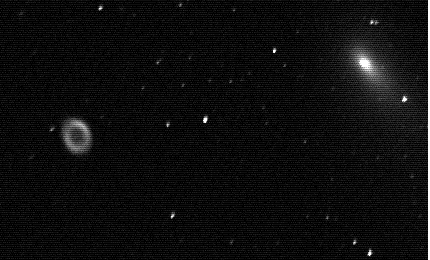
quote:De ringnevel zoals je zietOp maandag 8 mei 2006 21:17 schreef Frutsel het volgende:
wat is M57 ook alweer?
Titan in Motion: New Video of Landing on Saturn's Moon
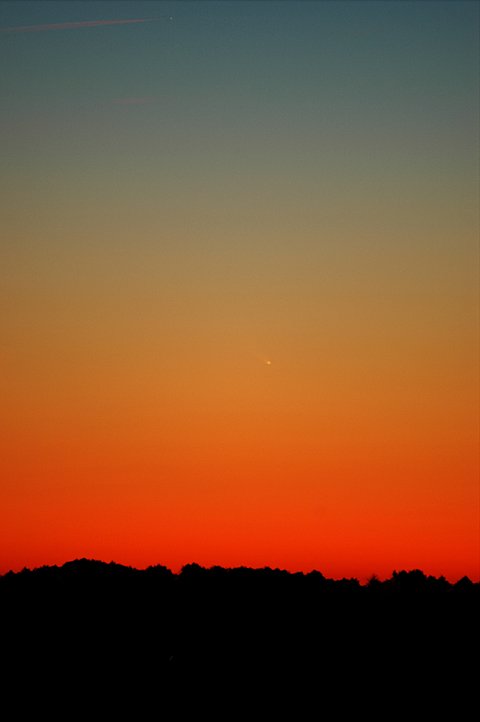
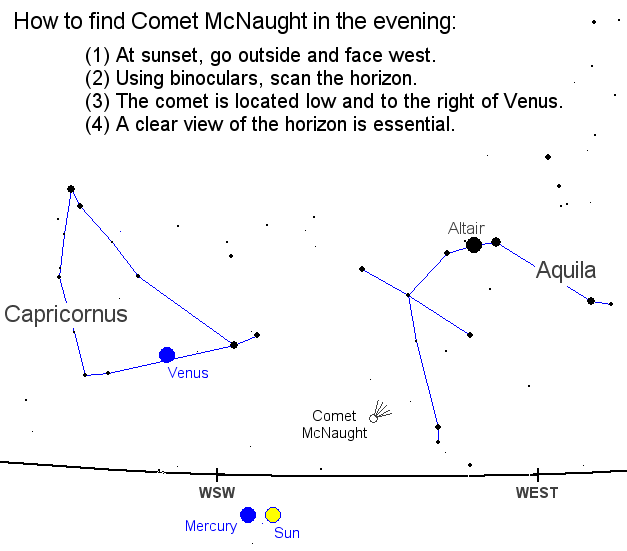
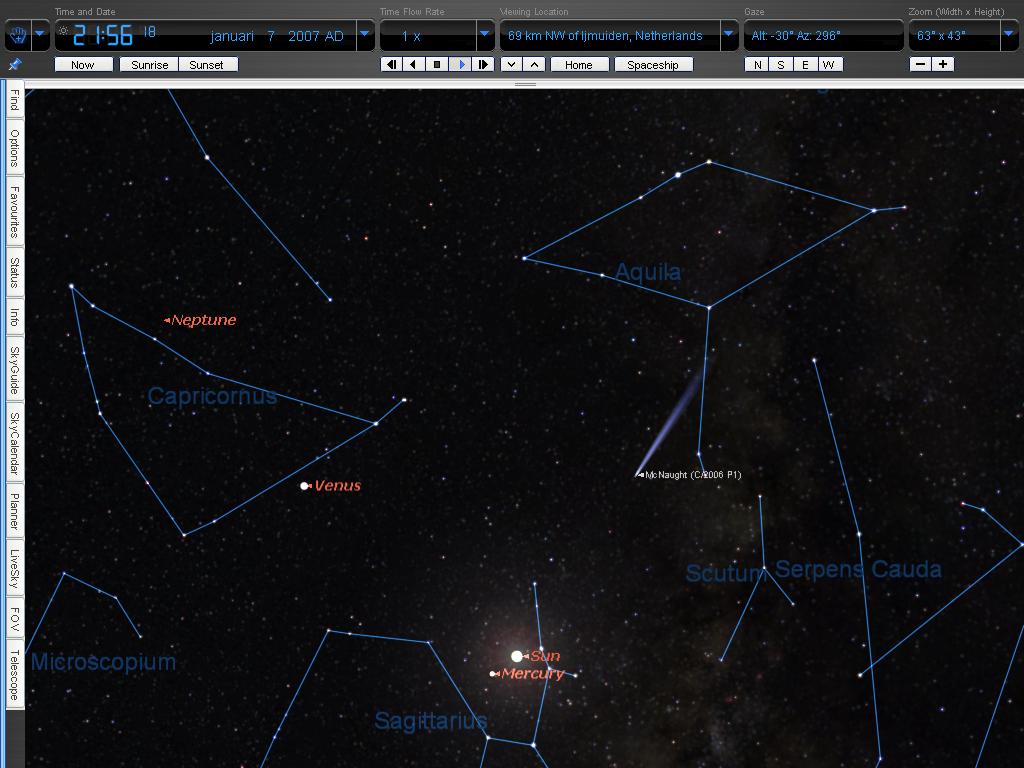
Probleem is echter dat hij moeilijk zichtbaar is, slechts alleen bij net zonsondergang/ondergang (komeet heeft min of meer dezelfde omloopbaan als de zon).
Maar het plaatje geeft wel direct aan waar je moet zoeken.
Starry Night Pro (plus), blijft leuk.
Dit zijn trouwens de volgende tijdstippen.
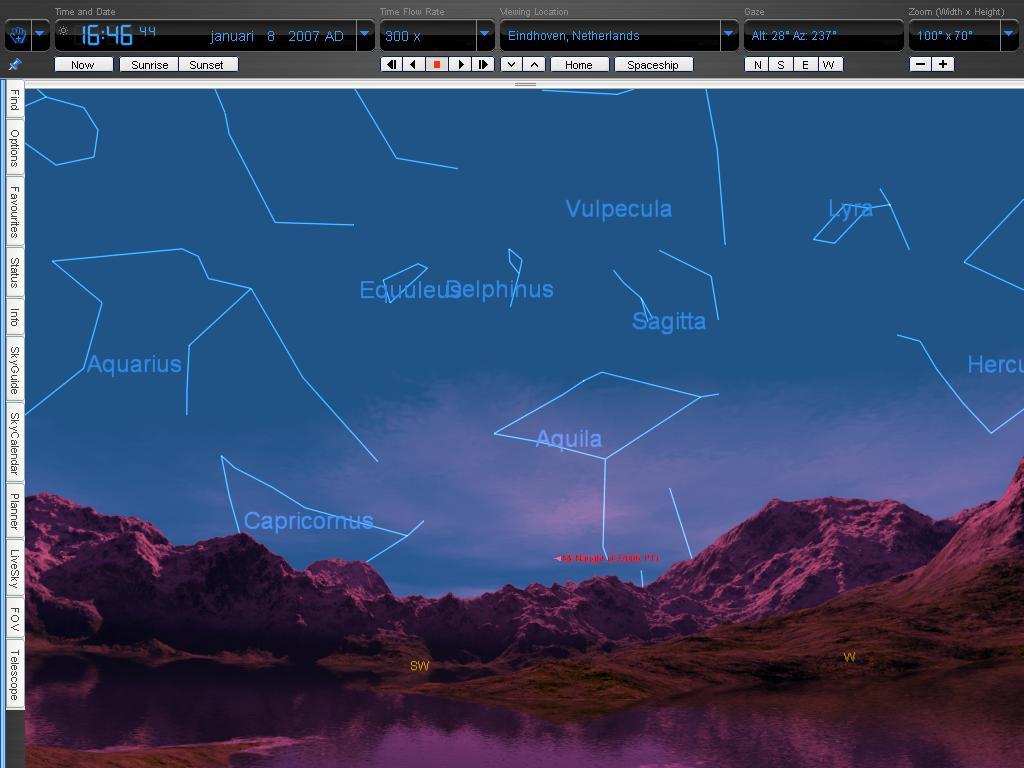
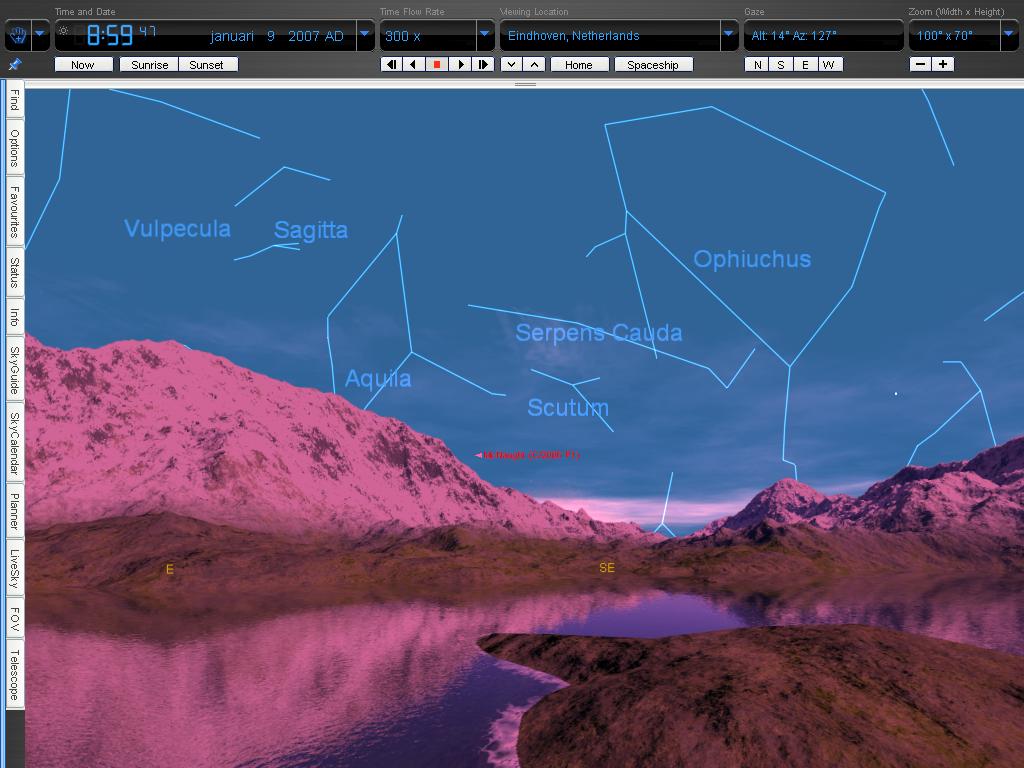
Mits je in Nederland woont tenminste.
[ Bericht 18% gewijzigd door Drugshond op 08-01-2007 18:21:31 ]
quote:Een komeet heeft opzich niets met het weer te maken, maar inderdaad een (grote) inslag wel.Op zondag 7 januari 2007 18:54 schreef Drugshond het volgende:
Ik ben er nog niet helemaal uit of dit een [DE] of een [WFL] discussie is.
Komeet is naar mijn mening een astro verschijnsel waarbij de aarde niet centraal staat. Een geregiseerde inslag daarentegen wel.
We moeten ff aan de bak achter de schermen van wat hoort nu bij wat ?
O ja, ff Starry Night Pro opnieuw installeren, die kan e.e.a. mooi visualiseren.
Dat kan een klimaatverandering teweeg brengen.
En dat is zoveel miljoen jaar geleden gebeurd, waardoor de dinosauriŰrs uitstierven.
quote:Maar dit is ook geen zuiver weerforum.Op zondag 7 januari 2007 21:30 schreef aloa het volgende:
Een komeet heeft opzich niets met het weer te maken, maar inderdaad een (grote) inslag wel.
Dat kan een klimaatverandering teweeg brengen.
En dat is zoveel miljoen jaar geleden gebeurd, waardoor de dinosauriŰrs uitstierven.
Opmerking : Gelijk de volgende momenten erbij gezocht waarbij de komeet zichtbaar zou zijn. Let ff op de tijdstippen van de simulatie.
de komeet aan de avondhemel


Let ff op de sunrise- en sunset data, in combinatie met de runs. Het wordt een close call.
quote:Dus we hebben nog wel ff de tijd om 'm te zien als het helder blijft?Op zondag 7 januari 2007 21:53 schreef -CRASH- het volgende:
Al je de komeet nog wil zien, moet je wel snel zijn (en het weer moet ook meespelen)
de komeet aan de avondhemel
[afbeelding]
quote:De Elementen.. je hebt gelijk.Op zondag 7 januari 2007 21:38 schreef Drugshond het volgende:
[..]
Maar dit is ook geen zuiver weerforum.
quote:Bron : www.astroforum.nl
Hallo allemaal,
Er is een (kleine) mogelijkheid dat we de volgende week gedurende enkele dagen deze komeet vlak voor zonsopkomst en vlak na zonsondergang met het blote oog kunnen zien.
Er is zelfs de kans dat we een fraaie staart kunnen zien, of nog zeldzamer: wel de staart terwijl de kop van de komeet zich nog onder de horizon bevindt.
Of dit werkelijk zo gaat gebeuren, dat weet op dit moment nog niemand. Het hangt heel sterk af van onbekende facoren. De helderheid kan een extra impuls ondergaan als gevolg van voorwaartse vertrooiing van het zonlicht door de stofdeeltjes van de komeet. (de komeet bevindt zich nu praktisch tussen de Zon en de Aarde in). Dit effect kan de komeet tot 2 magnitudes extra helder maken, waardoor in het gunstigste geval een negatieve magnitude van -2 op nog helderder bereikt zou kunnen worden, en de komeet mogelijk zelfs bij daglicht zichtbaar zou zijn. De voorwaarste verstrooing hangt echter sterk af van de grootte van de verstrooiende deeltjes en de golflengte van het licht. (Een soortgelijk effect zie je bij opnames van de ringen van Saturnus als de Cassinisonde zich in de schaduw van de planeet bevindt, en de ringen erg lijken op te lichten).
Maar zoals gezegd, het kan ook erg tegenvallen, en in dit geval zal het nog een hele toer worden om de komeet uberhaupt te zien. Een goed doorzichttige hemel en een geheel vrije horizon zijn sowieso vereist. 's ochtends kan tot de 10e een poging gewaagd worden, terwijl de fraaiste verschijningen aan de avondhemel te verwachten zijn van 10 tot en met 13 januari, met op de 12e de staart loodrecht op de horizon. Na de 13e verdwijnt de komeet naar de zuidelijke sterrenhemel. Het is duidelijk een kortdurende happening!
Je kunt het beste kijken vanaf een kwartier tot ruim een half uur voor/na
zonsopkomst/ondergang. Oftewel, het wordt waarnemen in de schemering met de zon hooguit 6 graden onder de horizon en de komeet er slechts enkele graden boven.
Nog wat aanvullende info van Jonathan Shanklin, de waarneemingsleider van de Engelse kometenwerkgroep:
http://www.ast.cam.ac.uk/~jds/tail26.pdf
Houd de komende dagen vooral de diverse astrosites in de gaten:
http://www.kometen.nl/index2.html
http://www.shopplaza.nl/astro/
http://www.fg-kometen.de/fgk_hpe.htm
http://www.ast.cam.ac.uk/~jds/
Een recente foto vanuit de Oostenrijkse Alpen:
Groeten,
Guus
Als ik deze ook nog te zien krijg (met het blote oog)
dan is het de vierde...
Komeet Halley - 1986
komeet Hyakutake - 1996
komeet Hale-Bopp - 1997
Deze drie waren mooi te zien met een lange staart.
Ik heb ook nog wel andere gezien... maar die waren minder spetaculaire.
quote:SN is ook een machtig stukje software voor dat soort dingen. In combinatie met een telescoop met motor kun je er leuke dingen mee doen.Op dinsdag 9 januari 2007 10:36 schreef addie het volgende:
Mooie simulaties DH!
Ik zat nog ff te kijken naar de Space Calendar of er nog leuke dingen in staan.
Maar dan is hij hier al niet meer zichtbaar.
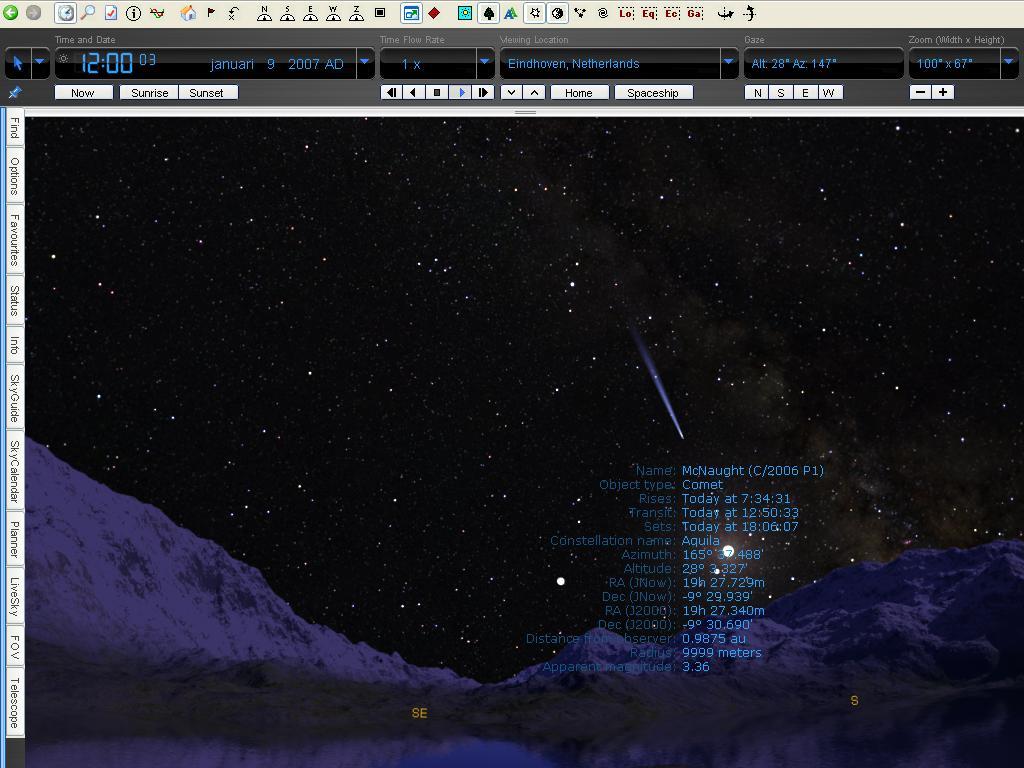
Zonder daylight krijg je het volgende te zien.
Kijk ook eens voor de grap naar de technische data behorende bij deze komeet.
quote:Zou je je misschien geroepen willen voelen de data eens toe te lichten?Op dinsdag 9 januari 2007 12:08 schreef Drugshond het volgende:
[afbeelding]
Zonder daylight krijg je het volgende te zien.
Kijk ook eens voor de grap naar de technische data behorende bij deze komeet.
Transit = Hoogste punt
Sets = ondergang
Constellation Name = In welk sterrenbeeld zichtbaar.
Azimuth = horizontale hoek ten opzicht van N
Altitude = vertikale hoek (max 90 graden).
RA/DEC weet ik niet exact (ik vermoed iets met bewegingsrichting van het object ten opzichte van de sterrenhemel) ?
Distance from Observer = meestal aangegeven in AU (1 AU = 149 598 000 kilometers)
Radius = Straal van het object (dit is dus een blok steen van 2 km in diameter)
Apperent Magnitude = Magnitude
quote:dank jeOp dinsdag 9 januari 2007 12:47 schreef Drugshond het volgende:
Rises = opkomst
Transit = Hoogste punt
Sets = ondergang
Constellation Name = In welk sterrenbeeld zichtbaar.
Azimuth = horizontale hoek ten opzicht van N
Altitude = vertikale hoek (max 90 graden).
RA/DEC weet ik niet exact (ik vermoed iets met bewegingsrichting van het object ten opzichte van de sterrenhemel) ?
Distance from Observer = meestal aangegeven in AU (1 AU = 149 598 000 kilometers)
Radius = Straal van het object (dit is dus een blok steen van 2 km in diameter)
Apperent Magnitude = Magnitude
Hmzzz, beetje zonde dat dit topic stil is komen te vallen.
Niet dat ik het volledige topic wil hebben voor [DE] (slechts een zeer beperkte deelverzameling hiervan wil hergebruiken). Maar toch, nu hebben we een komeet aan de horizon en geberud er nix mee. Terwijl de OP goed in elkaar zit en het wel degelijk een WFL-topic is..

7 Januari Duitsland: Belichtingstijd 1 seconde, bij 100 asa met een Canon 20D en 100 mm lens
Al kort na zonsondergang is de heldere kop van de komeet te zien. Een verrekijker toont ook de uitwaaierende gasstaart van de komeet. Voor amateurastronomen: de helderheid van de komeet bedroeg zondagavond al magnitude –1. Dat is ongeveer zo helder als de helderste ster aan de hemel, maar minder helder dan Venus, die op een twintigtal graden afstand aan de avondhemel staat.
De komeet werd op 7 augustus vorig jaar ontdekt door Robert H. McNaught met de 50-cm Uppsala Schmidt-telescoop op de berg Siding Spring in AustraliŰ. De komeet was toen lichtzwakker dan het verre planeetje Pluto, maar berekeningen door het Minor Planet Center gaven aan dat hij begin januari helderder zou kunnen kon worden. Op 12 januari scheert de komeet op een afstand van 25 miljoen km langs de zon. Dat is de halverwege de afstand van de planeet Mercurius tot de zon. McNaught blijft tijdens zijn reis om de zon ver van de aarde. De kortste afstand is nog 0,8 keer de afstand aarde-zon (AU, astronomical unit): een volle 119 miljoen km.
De sterke helderheidstoename van de komeet komt als een verrassing. Tot voort kort bevond de komeet zich van de aarde af gezien achter de zon. Daardoor was het tot begin dit jaar moeilijk te voorspellen hoe helder de komeet in werkelijkheid zou worden.

Boven: komeet McNaught aan de avondhemel. De komeet bevindt zich kort na zonsondergang laag boven de west-zuidwestelijke horizon. De zeer heldere planeet Venus bevindt een vijftien- tot twintigtal graden links van de komeet. Dat is ongeveer de breedte van een handspanne, gezien op armstand van het oog. De zon gaat omstreeks 16.50 uur onder en het einde van de schemering is omstreeks 18.15 uur.
Onder: wie het het wil proberen, kan komeet McNaught ook in alle vroegte ’s ochtends zien: kort voor zonsopkomst en laag boven de oost-zuidoostelijke horizon). aan de avondhemel. Probeer de komeet te vinden ten opzichte van de heldere planeten Mars en Jupiter. De ochtendschemering begint omstreeks 07.20 uur. De zon komt omstreeks 08.45 uur op.
Weersvooruitzichten
Wat het weer betreft boffen Nederland en BelgiŰ niet voor de waarneming van de komeet. Volgens Harry Geurts van het KNMI is de hele week juist ’s avonds de kans op bewolking het hoogst. Op vrijdag en zaterdag is de kans op een goede waarneming 's ochtends wat groter, omdat het dan juist opgeklaard is. Het is volgens Geurts een kwestie van veel geluk hebben, want er komt deze week veel slecht weer over onze streken.
Weer of geen weer: iedereen kan de komeet via internet zien! Van 11 tot 15 januari krijgt de zonnesatelliet SOHO (het Solar and Heliospheric Observatory), die zich op 1,5 miljoen km van de aarde bevindt, de komeet in beeld. De opnamen van SOHO zijn nagenoeg direct via internet te bekijken. Iedereen kan zo ook volgen wat er met de komeet gebeurt op het moment dat hij zich het dichtst bij de zon bevindt.

Meerdere linkjes
A January Surprise Comet! --> http://skytonight.com/observing/home/5089276.html
McNaughts Comet! Photo's -->http://spaceweather.com/comets/gallery_mcnaught.htm
McNaughts Orbit! Gif --> http://www.shadowandsubstance.com/
(Bron: Kennislink)
Maar ik kon niet vanuit m'n werkplaats richting
zonsopkomst kijken.....
Dacht ik, dat er vanavond dan misschien
wel een kans zou komen.....
Is er hier toevallig iemand die vanmorgen foto's heeft gemaakt
(dus geen spaceweather.com foto's)
quote:Ik heb vrijdag ook zitten kijken vanaf mijn werkterrein.Op vrijdag 12 januari 2007 16:11 schreef -CRASH- het volgende:
Het was vanmorgen eens een keer mooi helder.....
Maar ik kon niet vanuit m'n werkplaats richting
zonsopkomst kijken.....
Dacht ik, dat er vanavond dan misschien
wel een kans zou komen.....
Is er hier toevallig iemand die vanmorgen foto's heeft gemaakt
(dus geen spaceweather.com foto's)
Probleem was alleen dat er een gebouw ervoor stond.
Qua ligging en stadlicht was het perfect, maar nee nix gezien.
En veel kansen krijgen we niet meer.
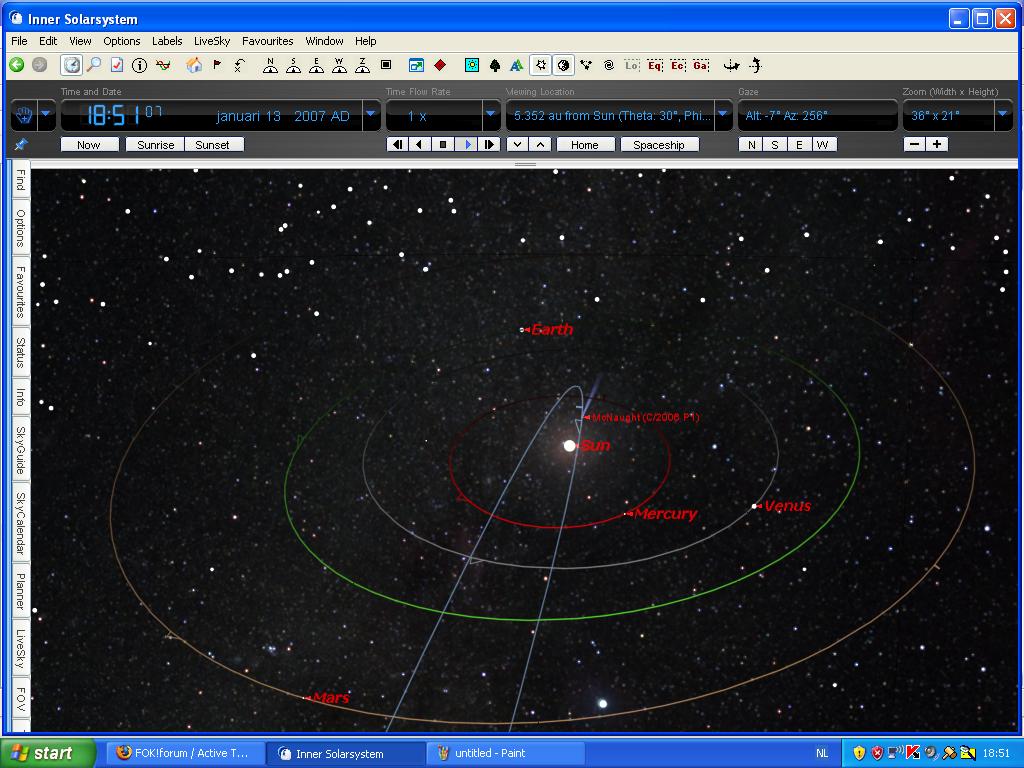
Orbital overview.
Comet McNaught is now visible in broad daylight.
Just hours ago, Mark Vornhusen took this picture
of the comet between clouds over Gais, Switzerland:
www.spaceweather.com
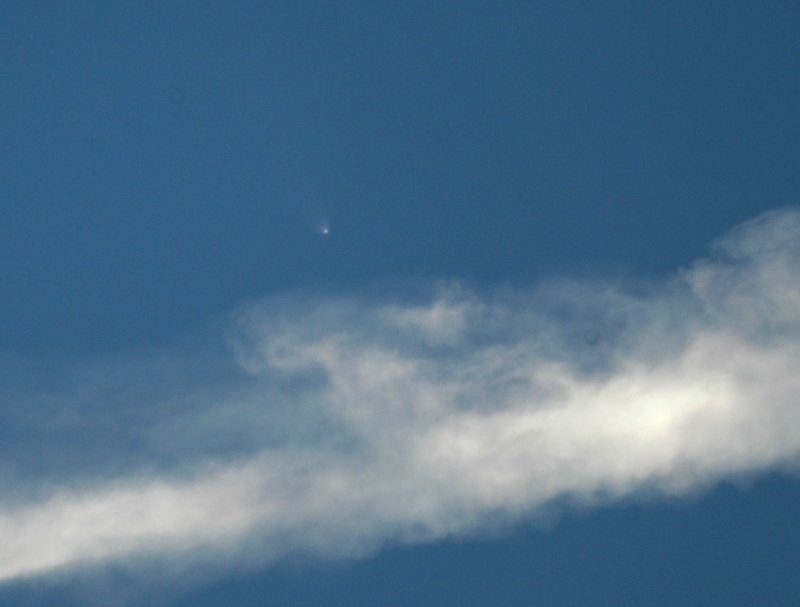
quote:Dan volg je de komeet via de SOHO (Solar & Heliospheric Observatory)Op zaterdag 13 januari 2007 23:24 schreef ne0c0rt3xx het volgende:
Verdammt...volgens mij benk te laat met kijken
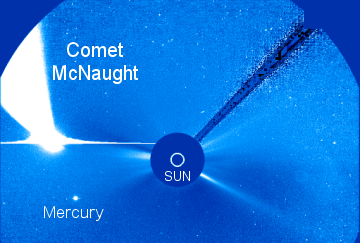
LASCO/EIT REAL TIME MOVIES
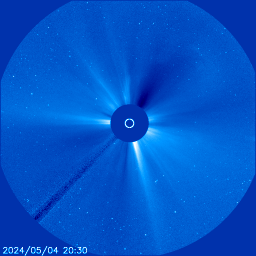
[ Bericht 8% gewijzigd door -CRASH- op 14-01-2007 10:40:01 ]
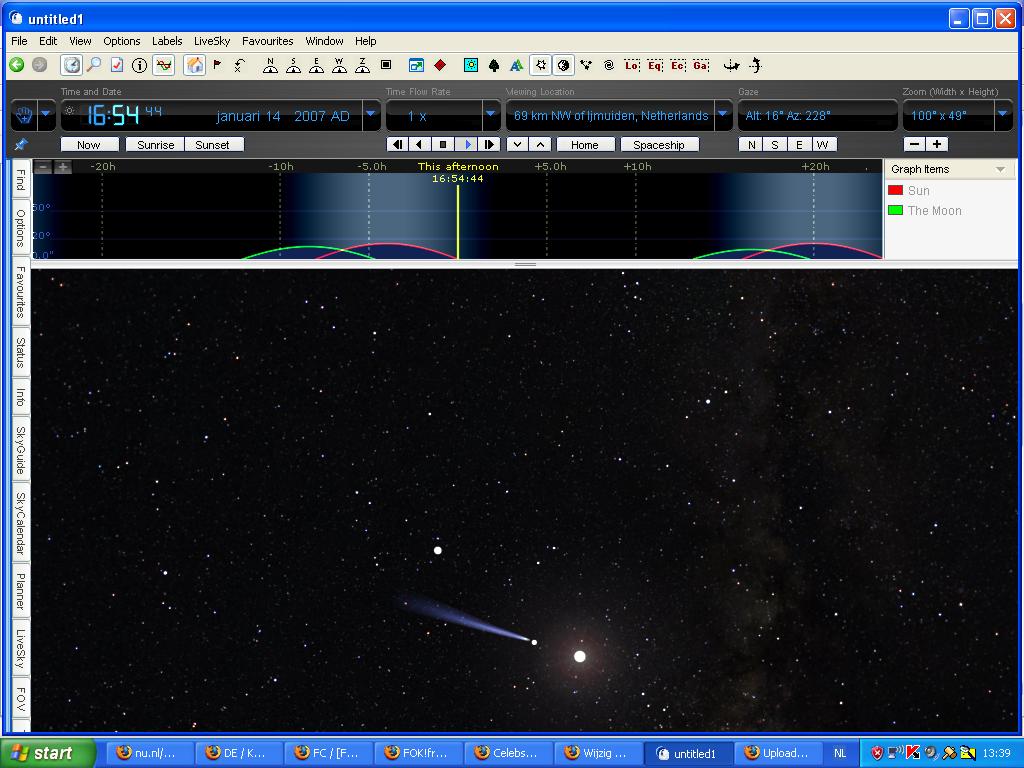
Horizon weggehaald en als tijdstip zonsondergang gekozen. Hij staat er dus iets links van. Vlakbij de planeet mecurius.
[ Bericht 0% gewijzigd door Drugshond op 14-01-2007 13:41:53 ]
quote:Er zijn op dit moment verschillende kometen en astroiden in omloop.Op zondag 14 januari 2007 13:26 schreef Robin2130 het volgende:
Weten jullie ook wanneer de volgende komeet te zien zal zijn?
Maar deze is/was zichtbaar met het blote oog.
Bekijk eens voor de grap deze site : http://www2.jpl.nasa.gov/calendar/
Dus de kans dat je de komeet bij
zonsondergang kunt zien wordt kleiner.
quote:De lucht is hier zo blauw als 't maar kan... (Zwolle).Op zondag 14 januari 2007 15:26 schreef -CRASH- het volgende:
De bewolking wordt alweer dikker.
Dus de kans dat je de komeet bij
zonsondergang kunt zien wordt kleiner.

Dan maar een heeel mooi SOHO plaatje
Van de komeet die op een lijn ligt met Mercurius.

quote:Ik ook niet alleen maar sterren...Op zondag 14 januari 2007 17:00 schreef IedeK. het volgende:
Net met mijn verrekijker even zitten turen, maar ik zie hem niet.
Zelf ook een poging ondernomen maar ook nix gezien. Wellicht had een kleuren glaasje uitkomst nog geboden (twijfel modus).







quote:ff een simulatierun opstarten (zonder daylight, en hoogste punt)

Of hij zichtbaar is bij daglicht is een groot vraagteken.
ff een run opgezocht toen de komeet het helderste was.
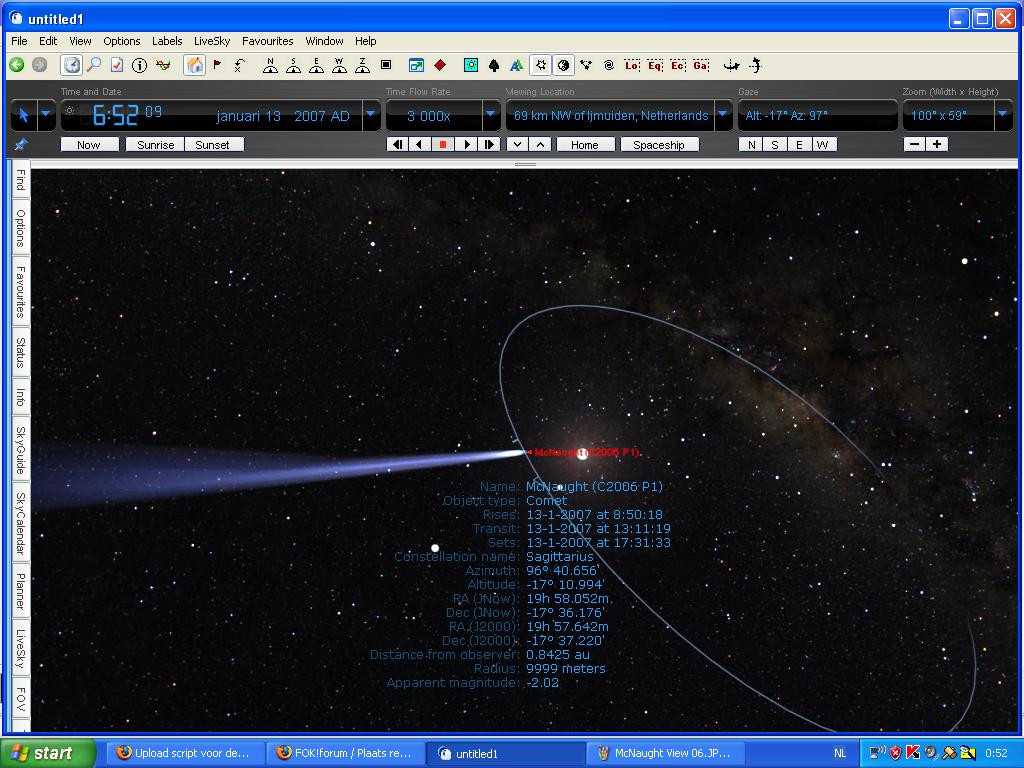
Een magnitude van -2.02 en dat is best hoog voor een komeet.
[ Bericht 3% gewijzigd door Drugshond op 16-01-2007 02:34:59 ]
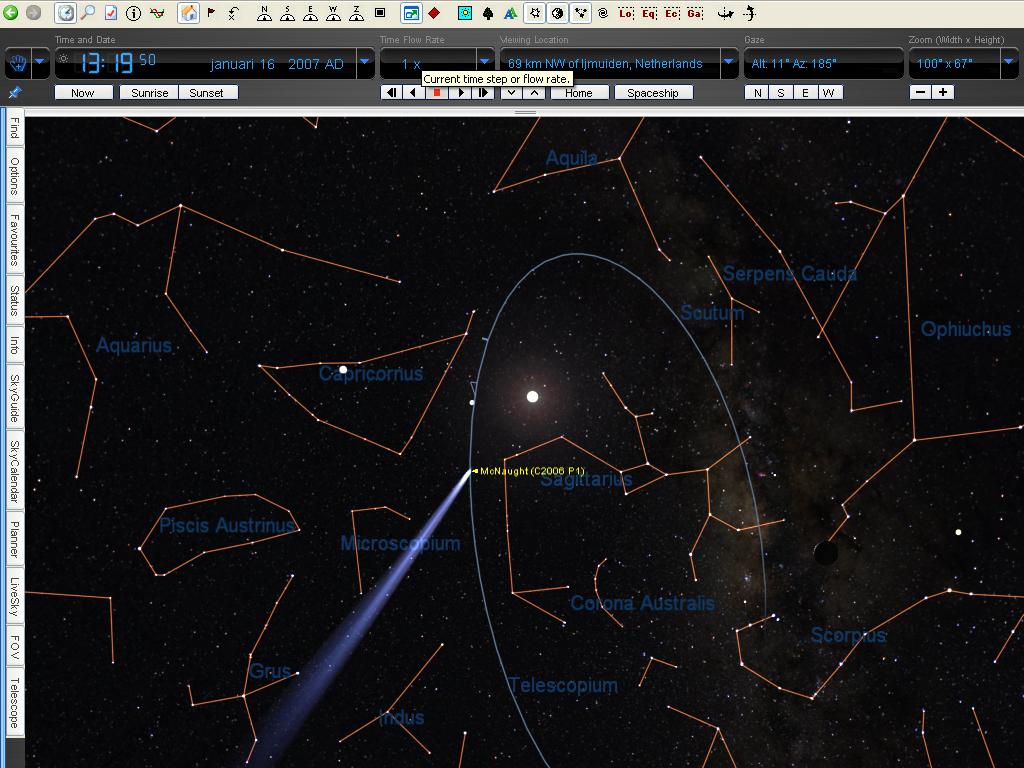
SOHO volgt komeet McNaught dichtbij de zon
Komeet McNaught zichtbaar bij daglicht
[Fotogallerij] DŔ komeet van 2007: McNaught
quote:Aww son'f'abitch!Op woensdag 17 januari 2007 20:52 schreef -CRASH- het volgende:
Comet McNaught is no longer visible from the northern hemisphere
Wat voor een programma gebruikt de TS trouwens in een paar van die screenshots?
quote:Ikke ?Op donderdag 18 januari 2007 00:45 schreef SpecialK het volgende:
[..]
Aww son'f'abitch!
Wat voor een programma gebruikt de TS trouwens in een paar van die screenshots?
quote:Oh sorry... ja klopt. Zo veel plaatjes dat ik de overgang over het hoofd zag
quote:Starry Night Pro Plus versie 5.0.2Op donderdag 18 januari 2007 00:52 schreef SpecialK het volgende:
[..]
Oh sorry... ja klopt. Zo veel plaatjes dat ik de overgang over het hoofd zag
Inmiddels zitten ze al op versie 6.x
Erg leuk programma, je kunt er veel (astro) dingen mee. En je kunt er de meest wilde dingen mee simuleren.
Met een telescoop + motor kun je zelfs met een druk op de knop alles uitrichten.
Nadeel wat ik laast had is dat de planetoide database niet zo heel volledig is (inmiddels 300.000 objecten bekend). Ik was op zoek naar 2004 MN4, die op collision koers lag met de aarde 2029 om wat gegevens boven tafel te halen. Maar dat brokje steen was nog niet verwerkt in de database (moet nog komen denk ik).
[ Bericht 0% gewijzigd door Drugshond op 18-01-2007 01:26:11 ]
quote:Cool! thanks!Op donderdag 18 januari 2007 00:58 schreef Drugshond het volgende:
[..]
Starry Night Pro Plus versie 5.0.2
Inmiddels zitten ze al op versie 6.x
Erg leuk programma, je kunt er veel (astro) dingen mee. En je kunt er de meest wilde dingen mee simuleren.
Met een telescoop + motor kun je zelfs met een druk op de knop alles uitrichten.
Nadeel wat ik laast had is dat de planetoide database niet zo heel volledig is (inmiddels 300.000 objecten bekend). Ik was op zoek naar 2004 AM4 die op collision koers lag met de aarde 2029 om wat gegevens boven tafel te halen. Maar dat brokje steen was nog niet verwerkt in de database (moet nog komen denk ik).
Geven ze trouwens dus die nieuwe data uit voor je programma om te downloaden of moet je dan echt een nieuwe versie installeren?
quote:Bij het opstarten haalt hij de laatste data gegevens binnen (automatisch).Op donderdag 18 januari 2007 01:01 schreef SpecialK het volgende:
[..]
Cool! thanks!
Geven ze trouwens dus die nieuwe data uit voor je programma om te downloaden of moet je dan echt een nieuwe versie installeren?
Maar in versie 6 zitten weer een aantal nieuwe features. Nog niet getest. Er is zelfs een nieuwe photo-book versie in omloop om een aantal objecten in X-ray te kunnen bekijken (maar dat is jammerlijk genoeg niet de pro-versie) Qua astro-software is dit toch wel een dikke mercedus.
Je moet maar eens kijken op de website : http://www.starrynight.com/
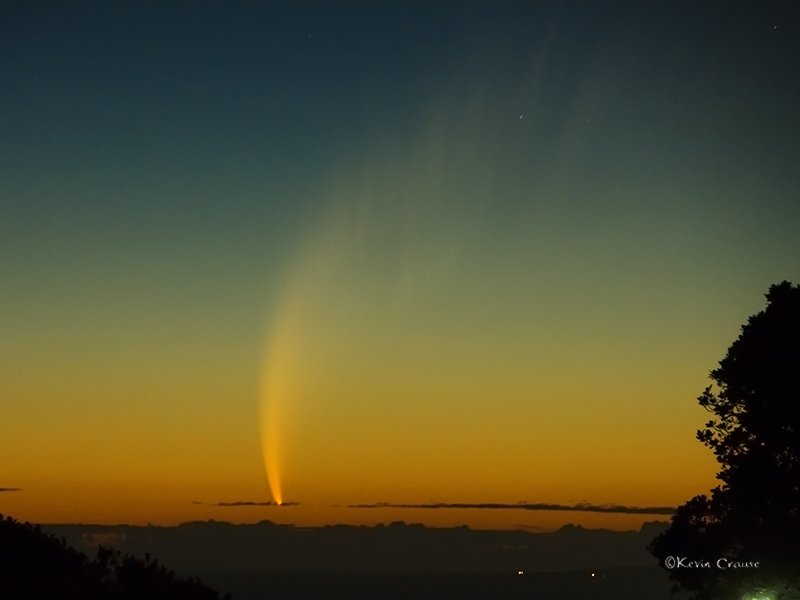
Foto credits: Kevin Crause, Mossel Bay, Western Cape, South Africa
quote:Die is vet !Op donderdag 18 januari 2007 18:47 schreef -CRASH- het volgende:
Die van het zuidelijk halfrond hebben werkelijk een adembenemend schouwspel....



[afbeelding]
Foto credits: Kevin Crause, Mossel Bay, Western Cape, South Africa
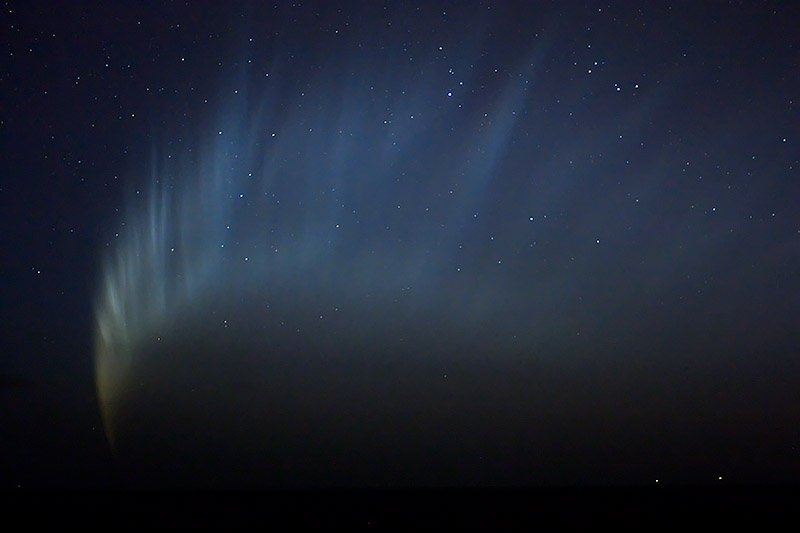
Foto Credits: Steve Crane, Cape Town, South Africa
quote:Is die er niet groter?Op zaterdag 20 januari 2007 20:03 schreef -CRASH- het volgende:
Wat zal het een groot spektakel geven van een meteorietenregen als de Aarde daardoor zou gaan
[afbeelding]
Foto Credits: Steve Crane, Cape Town, South Africa
Die wil ik wel als wallpaper.
Spottips voor staart:
http://www.astroversum.nl/nieuws/nieuws.html?subaction=showfull&id=1169284003&archive=&start_from=&ucat=24&
quote:deze is van www.spaceweather.comOp zaterdag 20 januari 2007 22:08 schreef IedeK. het volgende:
[..]
Is die er niet groter?
Die wil ik wel als wallpaper.
Of je moet naar de maker ervan mailen, vragen of je een grotere kan krijgen
quote:TOT 2 uur na zonsondergangOp zaterdag 20 januari 2007 22:09 schreef AstroNova het volgende:
Yeujde staart wordt misschien uit Nederland zichtbaar. Echt ongelofelijk die foto's!
Spottips voor staart:
http://www.astroversum.nl/nieuws/nieuws.html?subaction=showfull&id=1169284003&archive=&start_from=&ucat=24&
Die staart moet toch tig duizenden KM groot zijn
[ Bericht 3% gewijzigd door -CRASH- op 21-01-2007 13:46:52 ]
quote:Nou share with us, zou ik denken.Op zondag 21 januari 2007 00:02 schreef IedeK. het volgende:
Heb die gozer een mailtje gestuurd en net een 1280*1024 versie van de foto van hem gekregen.
quote:Op z'n minst de tip geverOp zondag 21 januari 2007 01:24 schreef Drugshond het volgende:
[..]
Nou share with us, zou ik denken.
Omdat jullie het zo lief vragen.
Hoe heeft die Zuid-Afrikaan je terug gemailt
In het engels of in het Zuid-Afrikaans (wat ie bij mij deed)
quote:Heel kort mailtje, maar het was wel engels.Op dinsdag 23 januari 2007 00:14 schreef -CRASH- het volgende:
@ IEdeK
Hoe heeft die Zuid-Afrikaan je terug gemailt
In het engels of in het Zuid-Afrikaans (wat ie bij mij deed)
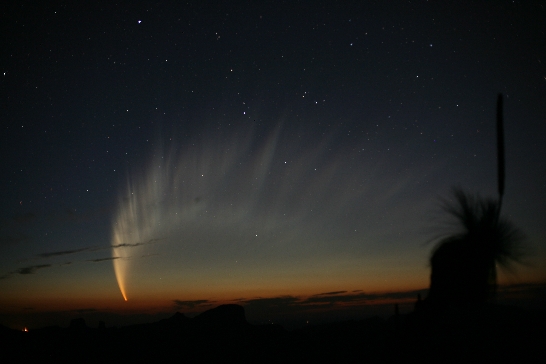
het noordelijk halfrond.
Kijk maar eens naar deze foto's
die op www.spaceweather.com staan.
En zoals het er nu buiten uitziet
zit ik vanavond ergens in he
veld foto's te maken.
[ Bericht 15% gewijzigd door -CRASH- op 23-01-2007 17:32:33 ]
Komeet McNaught en de Aurora Australis

Photo credits: Minoru Yoneto of Queenstown, New Zealand
quote:O M G!Op donderdag 1 februari 2007 17:08 schreef -CRASH- het volgende:
Die "daaronder" hebben ook al het geluk....
Komeet McNaught en de Aurora Australis
[afbeelding]
Photo credits: Minoru Yoneto of Queenstown, New Zealand
Bijdeweg: een kennis van ons is fotograaf en is de afgelopen 2 weken naar de Zuidpool geweest.
Zal eens vragen of hij de komeet ook gezien heeft.
quote:Als ie op de zuipool (antarctica) was...dan heeft ie waarschijnlijk 24 uur per dag licht.Op donderdag 1 februari 2007 17:11 schreef IedeK. het volgende:
[..]
O M G!
Bijdeweg: een kennis van ons is fotograaf en is de afgelopen 2 weken naar de Zuidpool geweest.
Zal eens vragen of hij de komeet ook gezien heeft.
Maar misschien heeft ie wel ergens onderweg een tussenstop gemaakt.
quote:Volgensmij is hij via, BraziliŰ en ArgentiniŰ gegaan.Op donderdag 1 februari 2007 17:18 schreef -CRASH- het volgende:
[..]
Als ie op de zuipool (antarctica) was...dan heeft ie waarschijnlijk 24 uur per dag licht.
Maar misschien heeft ie wel ergens onderweg een tussenstop gemaakt.
Ik denk ook niet dat hij echt precies op de geografische Zuidpool is geweest, maar meer met een boot naar de rand.
quote:Klopt op de simulaties van SN is het daar 24 uur licht.Op donderdag 1 februari 2007 17:18 schreef -CRASH- het volgende:
[..]
Als ie op de zuipool (antarctica) was...dan heeft ie waarschijnlijk 24 uur per dag licht.
Maar misschien heeft ie wel ergens onderweg een tussenstop gemaakt.
Encke heeft zijn beste zichtbaarheid rond 21 april 2007 met een magnitude van 3,93. Maar ik moet nog wat runs laten lopen.
quote:Mooie LSD picca,Op donderdag 1 februari 2007 17:08 schreef -CRASH- het volgende:
Die "daaronder" hebben ook al het geluk....
Komeet McNaught en de Aurora Australis
[afbeelding]
Photo credits: Minoru Yoneto of Queenstown, New Zealand
Is die ook orgineel verkrijgbaar ? Ik ben toch trigger happy geworden.
quote:Het is opeens supermistig. Laat maar weer.Op zaterdag 3 februari 2007 18:35 schreef ErikT het volgende:
Venus en Mercurius zijn nu heel goed te zien. En vannacht komt Saturnus. Ik denk dat ik mijn telescoop in elkaar ga zetten.
quote:Ik heb gister Saturnus gezien door de telescoop van de sterrenwacht Sonneborgh in UtrechtOp zaterdag 3 februari 2007 18:35 schreef ErikT het volgende:
Venus en Mercurius zijn nu heel goed te zien. En vannacht komt Saturnus. Ik denk dat ik mijn telescoop in elkaar ga zetten.
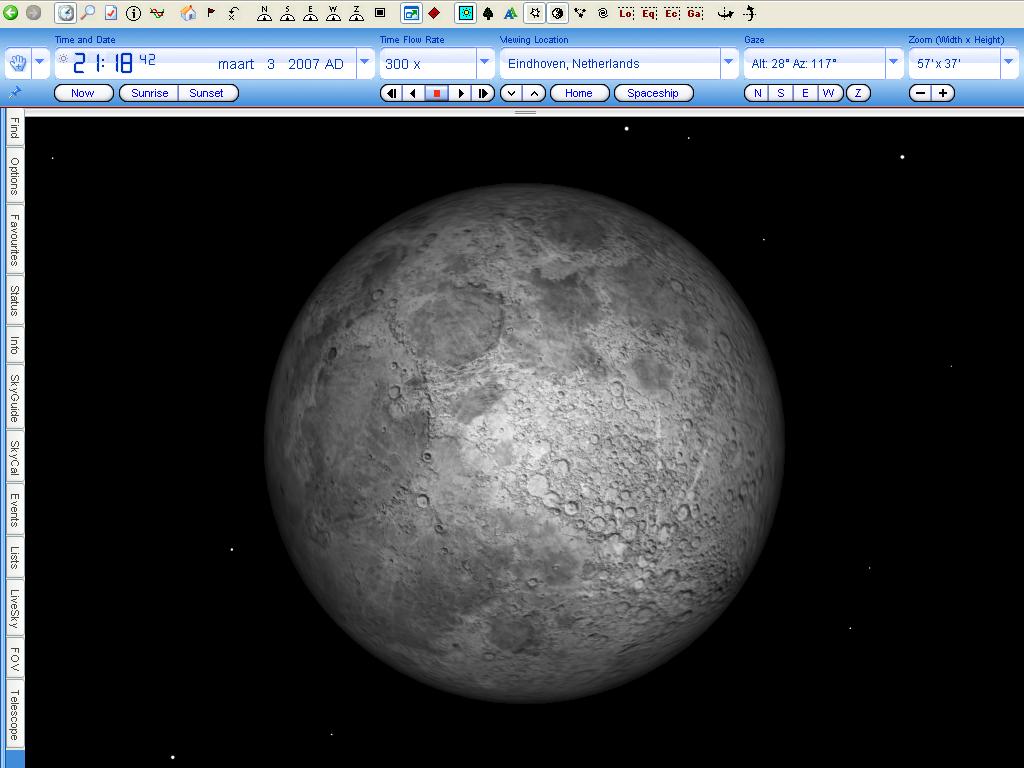
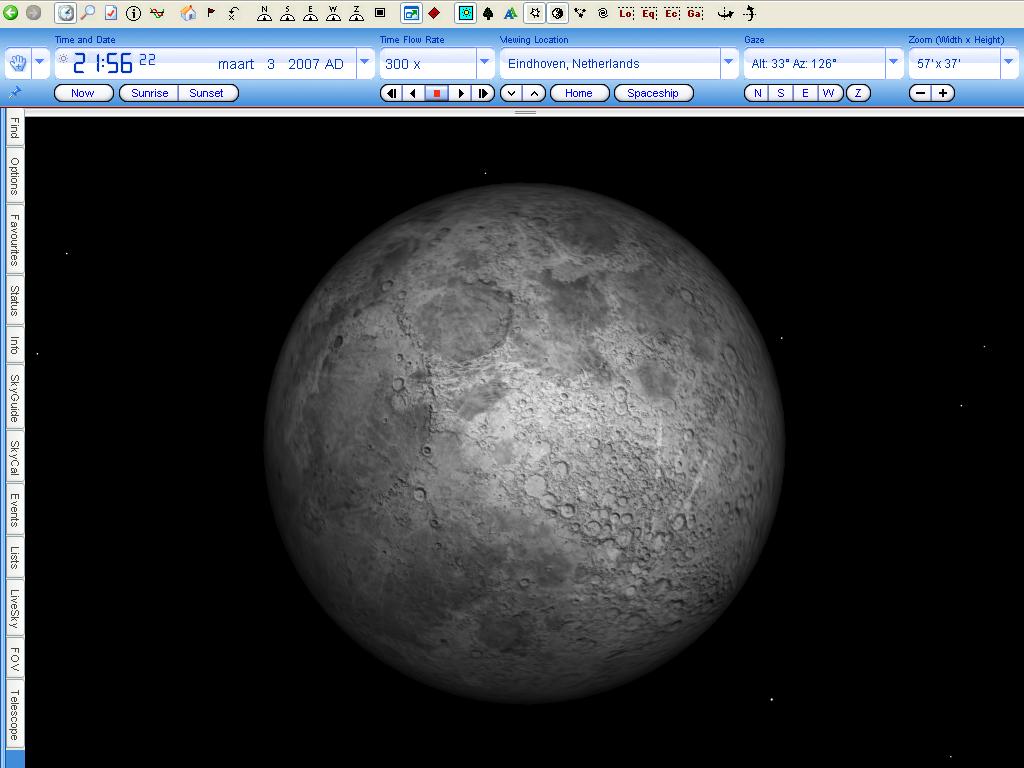
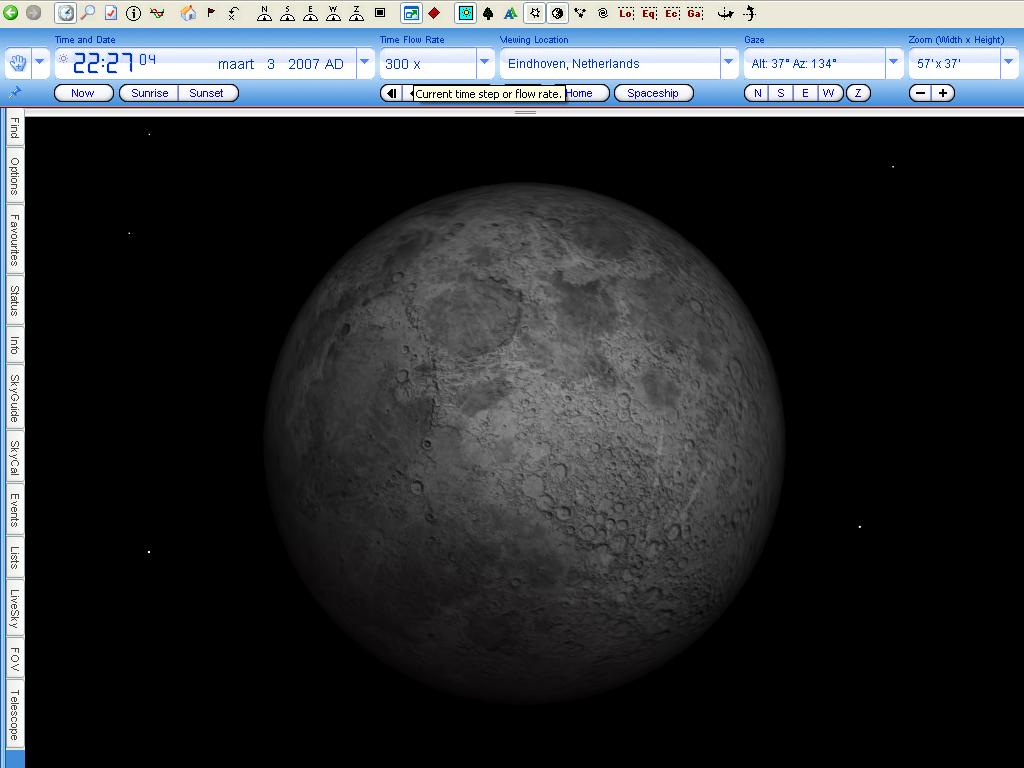
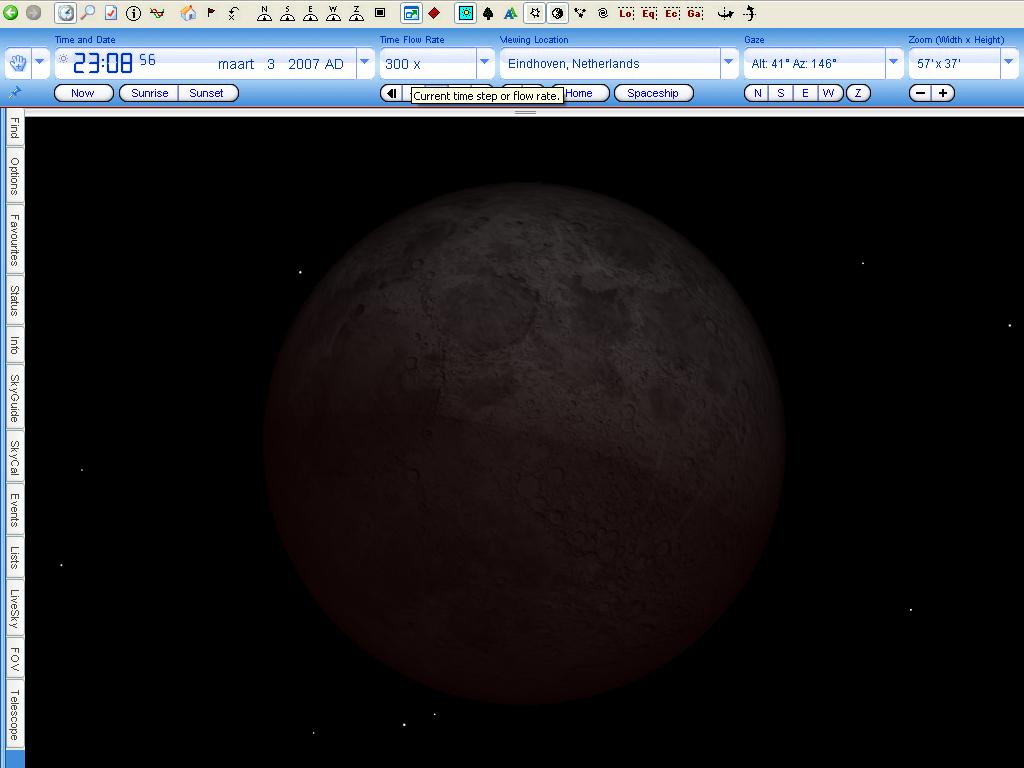
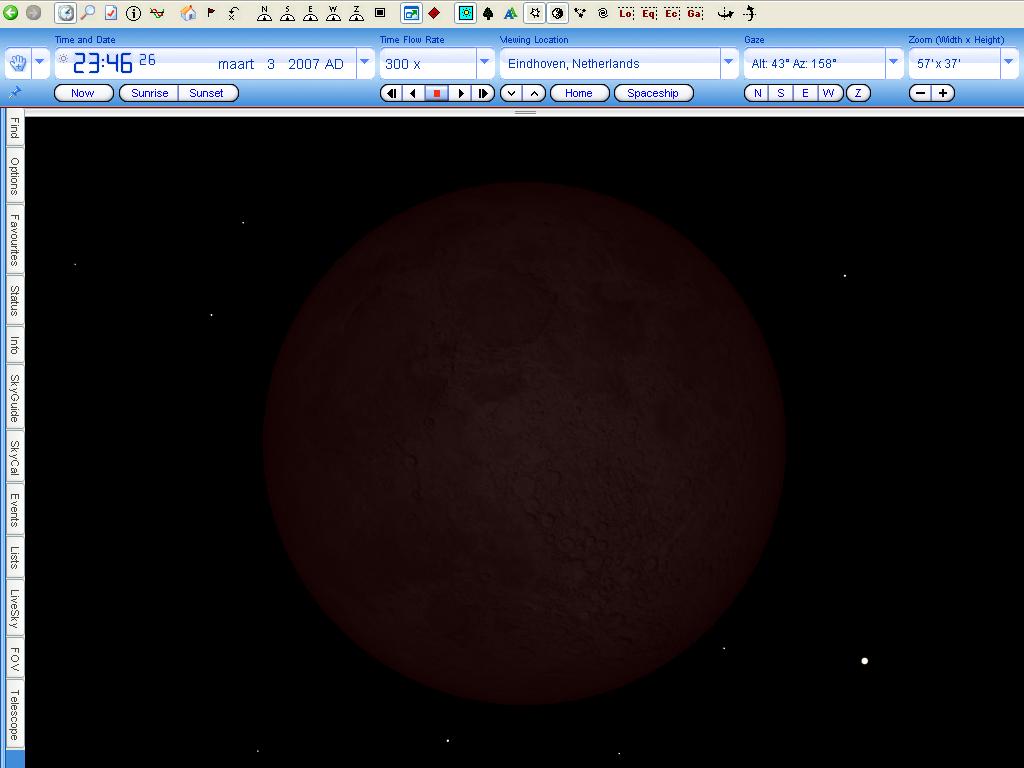
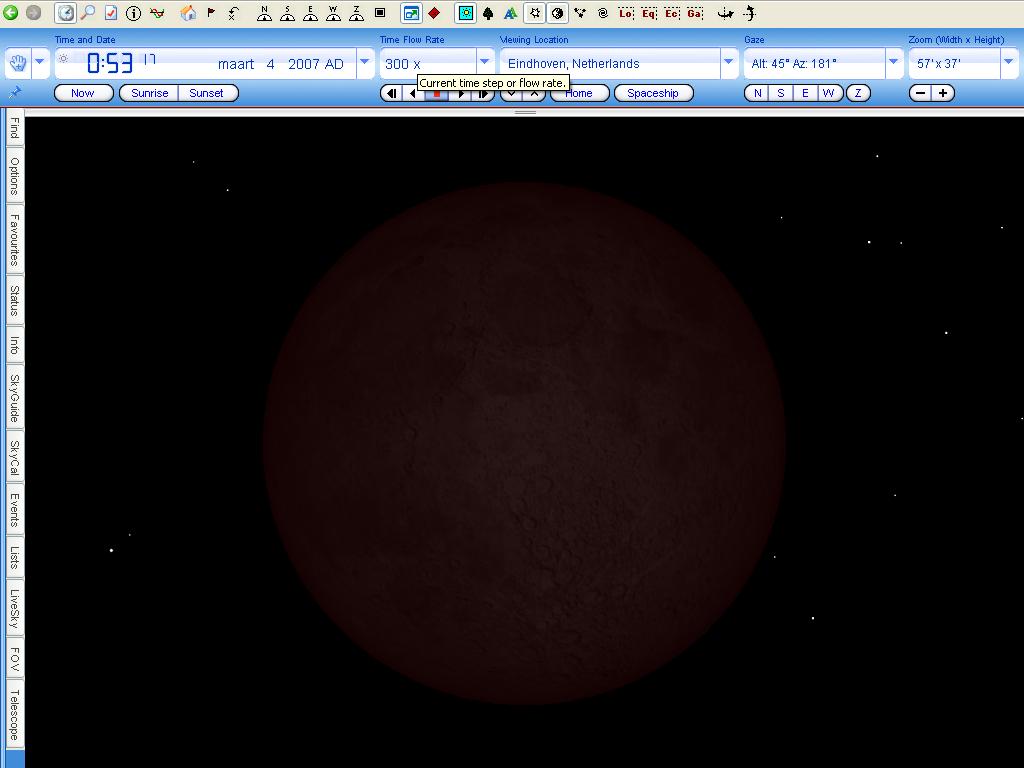

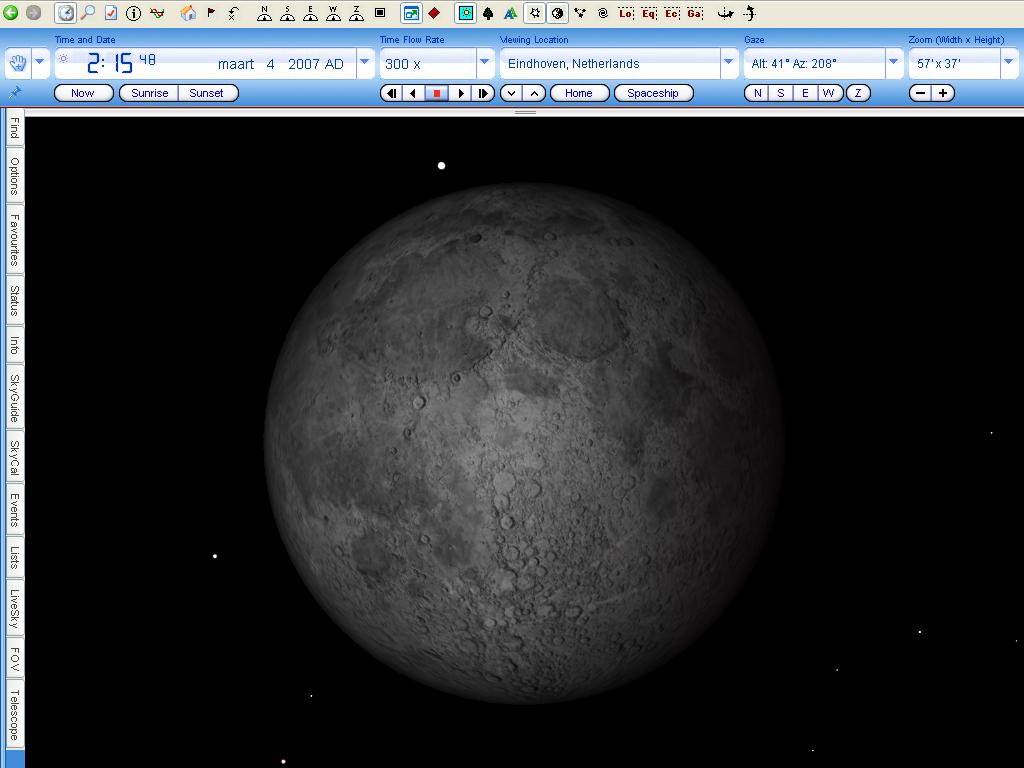
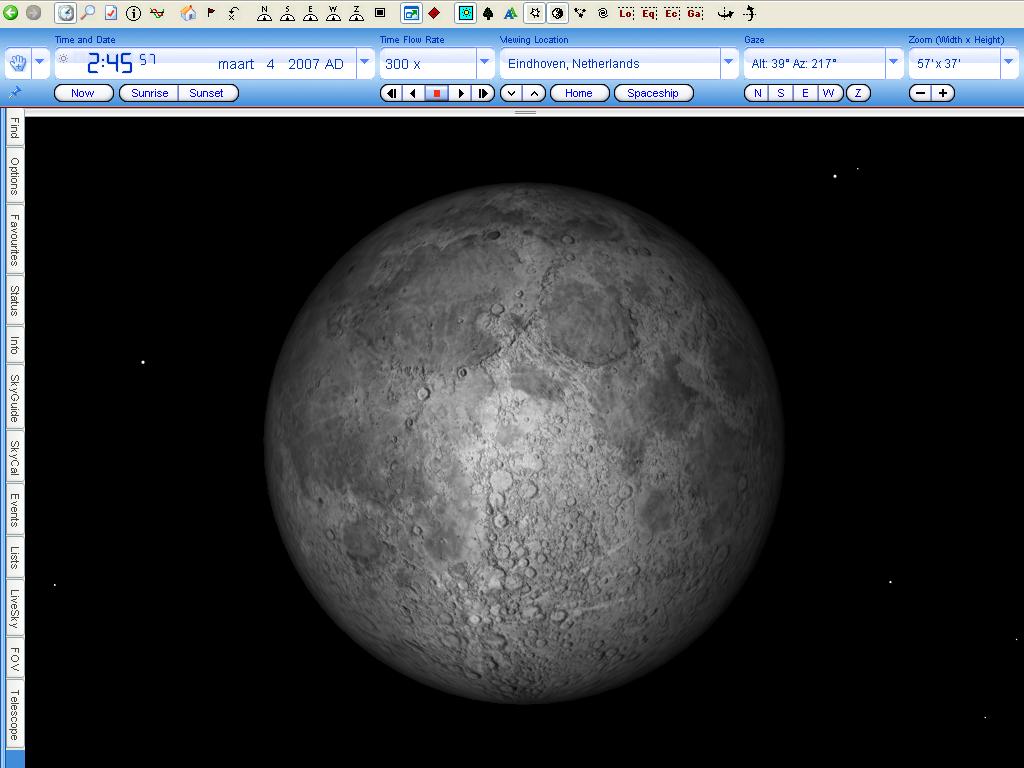
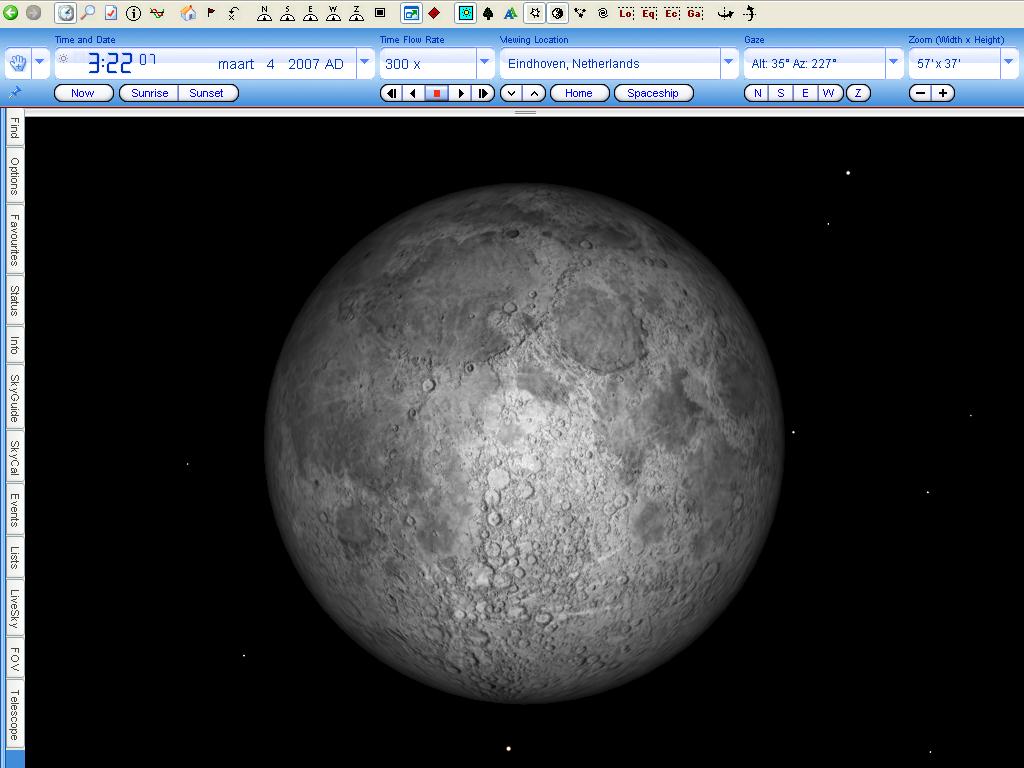
quote:Als je goed kijkt zie je ook de overgangen van de bijkegel, en hoofdkegel.Op zondag 4 februari 2007 15:35 schreef Meeldraad het volgende:
Cool dat je ook kan zien dat de maan een beetje rood kleurt!!
quote:Tja mail em zou ik weer zeggenOp zondag 4 februari 2007 00:27 schreef Drugshond het volgende:
[..]
Mooie LSD picca,
Is die ook orgineel verkrijgbaar ? Ik ben toch trigger happy geworden.
mkyoneto@es.co.nz
quote:Mail verzonden.Op zondag 4 februari 2007 20:09 schreef -CRASH- het volgende:
[..]
Tja mail em zou ik weer zeggen
mkyoneto@es.co.nz
quote:Een beetje? Ze wordt altijd helemaal rood en oranje!Op zondag 4 februari 2007 15:35 schreef Meeldraad het volgende:
Cool dat je ook kan zien dat de maan een beetje rood kleurt!!
quote:Dat ligt aan de toestand van de Aardse atmosfeer op het moment van verdusitering. Veel vulkanische as en stof kunnen bijvoorbeeld voorkomen dat het rode licht op de jusite manier breekt, waardoor de maan donkergrijs / zwart wordtOp zondag 4 februari 2007 23:39 schreef ErikT het volgende:
[..]
Een beetje? Ze wordt altijd helemaal rood en oranje!
quote:Klein vraagje over Mercurius...ik hoop dat jij of iemand anders hem weet.Op zondag 4 februari 2007 18:25 schreef star_gazer het volgende:
Oja, op 3 en 4 maart zijn ook de landelijke sterrenkijkdagen aan de gang. Kom eens langs bij Sterrenwacht Mercurius als je het geheel door een 15cm refractor uit 1922 wilt bekijken (of door mijn 20cm-dobson)
Op http://home.scarlet.be/andromeda/planet.htm staat hoek equator/baanvlak van Mercurius op precies 0 graden. Zelfs jupiter draait nog met 3.1 graden om de as. Heeft de korte afstand tot de zon hiermee te maken dat de kanteling 0 graden is (geworden) voor of nadat deze planeet in het baanvlak van Jupiter gekomen is
quote:Dit is zo'n vraagje als de reden voor de richting van rotatie om de eigen asOp dinsdag 6 februari 2007 15:43 schreef buachaille het volgende:
[..]
Klein vraagje over Mercurius...ik hoop dat jij of iemand anders hem weet.
Op http://home.scarlet.be/andromeda/planet.htm staat hoek equator/baanvlak van Mercurius op precies 0 graden. Zelfs jupiter draait nog met 3.1 graden om de as. Heeft de korte afstand tot de zon hiermee te maken dat de kanteling 0 graden is (geworden) voor of nadat deze planeet in het baanvlak van Jupiter gekomen is

 Ik hoop vanavond op discovery meer aanknopingspunten te vinden.
Ik hoop vanavond op discovery meer aanknopingspunten te vinden. 
Ik heb zelf nog nooit door zo'n ding heengekeken, maar weet iemand of het mogelijk is om bijvoorbeeld een dubbelster te kunnen herkenne met dit apparaat? Maw: doen of niet doen?
quote:Ik heb een tijd terug zo'n ding es geleend van een oom van me. Wat ik vooral erg vervelend vond, was dat het statief erg wankel was, en dat is knap kut als je 's winters een bepaald stelsel oid wilt bekijken. Veel dubbelsterren kun je trouwens ook al met een verrekijker scheiden, een mooi voorbeeldje zijn Alkor en Mizar in de steel van de grote beer.Op maandag 12 februari 2007 11:19 schreef buachaille het volgende:
Okay, voor 35 euro hoef je geen kwaliteit te verwachten, maar dit lijkt me wel een goede deal:
[afbeelding]
Ik heb zelf nog nooit door zo'n ding heengekeken, maar weet iemand of het mogelijk is om bijvoorbeeld een dubbelster te kunnen herkenne met dit apparaat? Maw: doen of niet doen?
quote:Mocht hij wat wankel op zijn stelten staan dan leen ik mijn vaders statief wel. Enne, misschien ooit nog wel eens: http://users.pandora.be/mollet.cornelis/telescoopbouw/index.html (klik onderin opOp maandag 12 februari 2007 12:54 schreef Haushofer het volgende:
[..]
Ik heb een tijd terug zo'n ding es geleend van een oom van me. Wat ik vooral erg vervelend vond, was dat het statief erg wankel was, en dat is knap kut als je 's winters een bepaald stelsel oid wilt bekijken. Veel dubbelsterren kun je trouwens ook al met een verrekijker scheiden, een mooi voorbeeldje zijn Alkor en Mizar in de steel van de grote beer.
EXTRA: Bouw je supermarkt-kijkertje om tot een volwaardige telescoop).
quote:36 euro is eigenlijk geen geld voor zoiets. Je kunt beter 36 euro besteden voor een simpel opstapje, dan 500 euro uitgeven voor iets wat later stof ligt te happen.Op maandag 12 februari 2007 13:15 schreef buachaille het volgende:
[..]
Mocht hij wat wankel op zijn stelten staan dan leen ik mijn vaders statief wel. Enne, misschien ooit nog wel eens: http://users.pandora.be/mollet.cornelis/telescoopbouw/index.html (klik onderin op
EXTRA: Bouw je supermarkt-kijkertje om tot een volwaardige telescoop).
Doen zou ik zeggen.
quote:Hmm... volgens mij heb je nog beter beeld als je gewoon met het blote oog kijkt. Maar aan de andere kant, het is geen geld dus daar kan je wel een gokje op wagenOp maandag 12 februari 2007 11:19 schreef buachaille het volgende:
Okay, voor 35 euro hoef je geen kwaliteit te verwachten, maar dit lijkt me wel een goede deal:
[afbeelding]
Ik heb zelf nog nooit door zo'n ding heengekeken, maar weet iemand of het mogelijk is om bijvoorbeeld een dubbelster te kunnen herkenne met dit apparaat? Maw: doen of niet doen?
[ Bericht 39% gewijzigd door Drugshond op 12-02-2007 17:12:40 ]







